
Durango Bill's
Giant Sequoias
Growing Giant
Sequoias near Durango, Colorado
This web page is a log of the author’s “horticultural experiment” to get a grove of Giant Sequoia (Sequoiadendron giganteum) trees to grow adjacent to the author’s home some 6 linear miles west of Durango, Colorado. Hopefully, this log will also help others (e.g. provide a “how to” guide) who might be interested in growing Giant Sequoias.
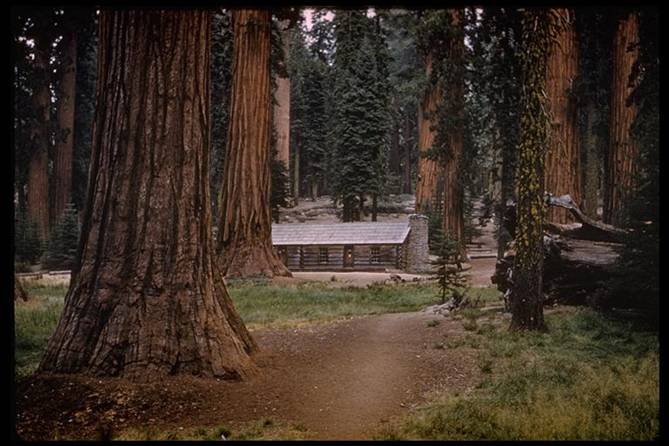
No, the author’s Giant Sequoia trees aren’t this big . . . yet. The above photograph shows a real cabin (now a museum) in the Mariposa Grove in Yosemite National Park. Credit should be given to Charles Webber © California Academy of Sciences. The original photograph and photographs of other Giant Sequoias can be seen at:
http://calphotos.berkeley.edu/cgi/img_query?query_src=photos_index&where-lifeform=any&rel-taxon=equals&where-taxon=Sequoiadendron+giganteum
At one time, Sequoias were native to Colorado as per the picture below which shows a fossilized stump of a Sequoia in Florissant Fossil Beds National Monument. (About 185 miles northeast of the author’s home.) The picture is courtesy of the NPS - the original photo can be seen at:
http://www.nps.gov/imr/customcf/apps/pgallery/photo.cfm?pid=2627&aid=442&gid=442
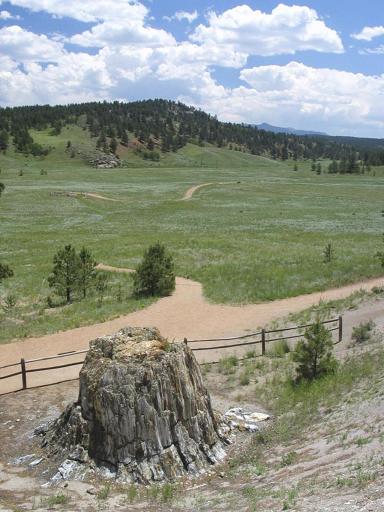 From http://www.nps.gov/parkoftheweek/flfo.htm
:
From http://www.nps.gov/parkoftheweek/flfo.htm
:“The massive petrified Sequoia stumps at Florissant are some of the largest diameter petrified trees in the world.”
They were probably still living in Colorado up to 7 million years ago, but changes in weather patterns brought about by the “ice ages” (http://en.wikipedia.org/wiki/Pleistocene and http://en.wikipedia.org/wiki/Quaternary) finished them off in the local area. As of now, their only native habitat is restricted to several dozen small groves on the western slope of California’s Sierra Nevada Mountains. http://en.wikipedia.org/wiki/List_of_sequoia_groves
The side effects of climate change and pollution (e.g. ozone) are beginning to threaten their existence in these last groves in the Sierras. (Please see “The IUCN Red List of Threatened Species - Sequoiadendron giganteum” at http://www.iucnredlist.org/details/34023 ) There are multiple locations around the world where they have been introduced, and seem be living OK. If the author’s efforts are successful, perhaps we can add “Successfully reintroduced to Colorado” to this list.
The sections below give more information about:
1) Local climate/Growing conditions for the “Giant Sequoia experiment”
2) Links to Internet sources for information about growing Giant Sequoias
3) The “Horticultural experiment” - a log of the author’s efforts to grow Giant Sequoias from seeds as well as seedlings purchased from commercial nurseries
4) The sad ending to the experiment. I have removed the Giant Sequoia trees as per the request of the local district board. As detailed at the end of this page, it is my opinion that the Giant Sequoias would have added to local property values as well as providing biodiversity protection for potential beetle attacks against our singularly predominant local tree - Ponderosa Pines.
Local
climate/Growing conditions
Elevation: 7,400 feet above sea level
Average winter nighttime temperature is about 5 to 10 degrees F with extreme lows down to 10 below F. (USDA Zone 6) Daytime summer temperatures average in the low 80’s with extreme highs near or slightly above 90 degrees F. Precipitation averages 23 to 24 inches per year (Local average measurement by the author - Giant Sequoias normally prefer double this amount.) May and June are dry with average rainfall of about one inch each while July, Aug., and Sept. average about 2.5 inches each.*
The ground is usually snow-covered from early-mid December through mid-late March. Humidity is low throughout the year with summertime dewpoints rarely above 55 degrees F. Winds are mostly light which is important during the critical winter season.
The last frost in spring is usually late May while the first frost in the fall is about late September.
*Climate change (global warming) appears to be changing previous precipitation patterns. Winter snowfall may tend to become lighter while the summer “monsoon” is a local phenomenon that may be expanding its time extent. (e.g. Historical records show that July used to be drier than what has been observed recently.)
Seasonal
distribution of average precipitation
Location Jan Feb Mar Apr May Jun Jul Aug Sep Oct Nov Dec Tot
SNP-GF31 7.48 7.70 6.65 4.77 1.79 0.43 0.11 0.17 0.44 1.55 4.10 7.91 43.11
SNP-GF61 6.43 6.19 5.88 5.18 1.71 0.40 0.08 0.42 0.66 1.40 6.43 7.23 42.01
Durango 2.41 2.08 1.81 1.80 1.09 0.86 2.37 2.61 2.41 2.06 1.85 2.16 23.45
Average Snowfall
Location Jan Feb Mar Apr May Jun Jul Aug Sep Oct Nov Dec Tot
SNP-GF31 37.7 36.2 40.0 25.6 4.6 0.3 0.0 0.0 0.1 1.8 12.8 28.9 187.9
SNP-GF61 N/A N/A N/A N/A N/A N/A N/A N/A N/A N/A N/A N/A N/A
Durango 24.6 22.6 18.4 10.4 0.7 0.0 0.0 0.0 0.0 0.9 12.2 19.0 108.9
Notes
N/A = Not Available
SNP_GF31 = Sequoia National Park - Giant Forest - Avg. from 1931 to 1968
SNP-GF61 = Sequoia National Park - Giant Forest - Avg. from 1961 to 1990
http://www.wrcc.dri.edu/cgi-bin/cliMAIN.pl?cagian+sca
(Most Sequoia groves have an underground water supply for the dry summer.)
Durango = The author’s measurements 6 miles west of Durango. (July 1998 - present) This location will be wetter and cooler than other local measurements from valley locations - including observations taken downtown and at the Durango airport. Durango averages will change with time.
Native vegetation
Primarily Ponderosa Pine ( http://coopext.colostate.edu/4DMG/Trees/pndrosa.htm ),
Gamble Oak ( http://www.coopext.colostate.edu/4DMG/Trees/gamble.htm ),
some Juniper ( http://www.colostate.edu/Depts/CoopExt/4DMG/Trees/juniper2.htm ),
and open meadows. Shady moist areas have a few native Aspen Trees.
Soil conditions
Local soil is derived from layers of shale and sandstone. The trees will be growing in decomposed shale which tends to form a very hard, dry clay. Soil pH is probably slightly alkaline (but not measured). (For example, see: http://www.sanjuanmountainnurseries.com/faqs.php?id=2 ) Giant Sequoias prefer soil that is neutral to slightly acidic. The local terrain slopes toward the north and east, and is well drained.
Additional
information for growing Giant Sequoias
The following websites have additional information for anyone interested in growing Giant Sequoias.
Grow them yourself
http://giantsequoias.blogspot.com/
http://www.treedazzled.com/shoot/2005/05/growing_giant_s.html
http://www.redwoodworld.co.uk/growing.htm
http://trees.martinsvillenj.com/gsseedsummary.htm
Books
http://www.sequoiahistory.org/books/booktree.htm
Nurseries (if you want to order seeds, seedlings via the Internet)
Welker’s Grove Nursery (best source for seedlings) http://www.giant-sequoia.com/homepage/ and http://search.ebay.com/_W0QQsassZkylerkris
http://www.jlhudsonseeds.net/SeedlistSA-SH.htm Best seed price (Packet = 100 to 500 seeds)
Also
http://search.ebay.com/search/search.dll?from=R40&_trksid=m37&satitle=%22giant+sequoia%22&category0=
http://www.plumcreektrees.com/ShowProduct.aspx?ProductID=85
http://www.datreestore.com/
http://www.nwplants.com/plants/trees/seq_seq_gig_index.htm
(Note: If you are thinking of buying seedlings, “bare root” shipping to reduce shipping costs will greatly reduce the probability that the seedlings will survive.)
General information on Giant Sequoias (Cultivation, Horticulture, etc.)
http://www.rngr.net/Publications/tpn/32/32_2_3_8.pdf/file
http://www.pfaf.org/database/plants.php?Sequoiadendron+giganteum
http://www.na.fs.fed.us/pubs/silvics_manual/Volume_1/sequoiadendron/giganteum.htm
http://en.wikipedia.org/wiki/Sequoiadendron
http://www.nps.gov/history/history/online_books/science/hartesveldt/contents.htm
http://www.sustainablehorticulture.com/bigtree.htm
And remember, for more information: “Google is your friend”
The
“Horticultural Experiment”
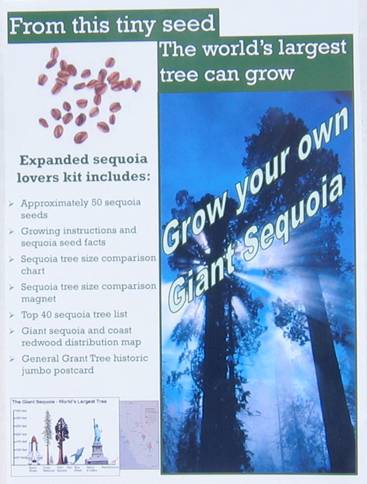 Oct. 4, 2007
Oct. 4, 2007While on a vacation trip that included a visit to Sequoia National Park, I caught a case of “Giant Sequoia Fever”. While browsing through a gift shop at one of the visitor centers in Sequoia National Park, I noticed that they were selling seed packets with the following headline:
“From this tiny seed
The world’s largest tree can grow
Grow your own Giant Sequoia”
Package by Sequoia Natural History Association
The world’s largest tree can grow
Grow your own Giant Sequoia”
Package by Sequoia Natural History Association
The seed packets were “talking to me”. The local climate west of Durango, Colorado is similar to that in Sequoia National Park except total precipitation averages about 23-24 inches per year (11-year average as measured by the author) instead of the very heavy winter precipitation in the Sierras. Our local native vegetation is predominantly Ponderosa Pine Trees which I also noticed were adjacent to some of the Giant Sequoia groves in the park. I was wondering: “Would it be possible to grow Giant Sequoias at home?”
I bought a seed packet with “Approximately 50 sequoia seeds”, growing instructions, etc. The “horticultural experiment” began.
Mid to late Oct. 2007
After returning home from my vacation trip, I searched the Internet for information, growing instructions, etc. for Giant Sequoias. This included nurseries for supplies/pots.
Nov. 5, 2007
Ordered 100 more Sequoia seeds from eBay store “Bergs Enterprizes”. The seeds arrived Nov. 14, 2007
http://stores.ebay.com/Bergs-Enterprizes
Ordered sixty one-gal pots from http://www.greenhousemegastore.com
My game plan for the seeds is to give them a controlled “man made winter” and germinate them in the spring. (Buzzword is “stratification”.)
Nov. 11, 2007
Ordered five 8-12 inch seedlings from eBay store “PJC98's unique trees and shrubs”. http://stores.ebay.com/PJC98s-unique-trees-and-shrubs This was an attempt to have a few Giant Sequoia trees that had a 2-year head start on my seeds.
Nov. 17, 2007
The five seedlings arrived from PJC98 - plants looked healthy but were shipped “bare root”. (Soil had been washed away from the roots to reduce shipping costs.) I have my fingers crossed about the bare roots. Planted them outdoors that afternoon. Used “Hyponex, Eco, and Miracle-Gro” potting mixes for “nest” material. 2 gallons of water (for each) were poured into seedling nests.
Nov. 23, 2007
First snow - about 5 inches.
Dec. 1, 2007
Heavy rain, some snow.
Dec. 7, 2007
More rain and wet snow. Seedlings were bent over from wet snow. The snow was removed from each seedling and snow was piled up around seedlings to help them remain upright from subsequent snows. Most of the seedlings had significant discoloration including browning.
Dec. 9, 2007
Six inches of snow. Seedlings mostly buried.
Dec. 11, 2007
Another snow. If the seedlings weren’t buried before, they are now.
Dec. 15, 2007
Temperature is 2 below. Seedlings covered by snow.
Dec. 28, 2007
Temperature this morning is 8 below. Seedlings covered by snow.
Feb. 4, 2008
Snow depth reaches a maximum of 46 inches. Snow measurements indicate ground is not frozen underneath the snow.
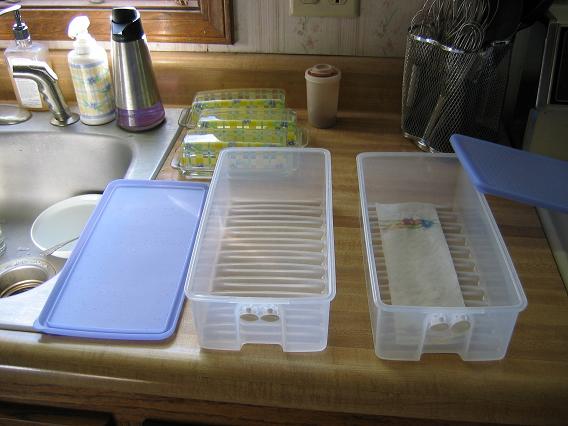 Feb 17, 2008
Feb 17, 2008I started the “stratification” process for the seeds from Bergs Enterprizes and “Grow your own”. Soaked all seeds for 9 hours (overnight) in cool water. Used Hydration Station water (purified water) for all operations until seeds were in pots. “Grow your own” advertised “Approximately 50 sequoia seeds” - actual count was 83. Bergs Enterprizes advertised 100 seeds. Actual count was 100.
Feb 18, 2008
Slightly dampened “sandwiches” of paper towels with seeds in middle. Both seed batches were placed in 3.5 x 6 x 12 inch plastic boxes. The top of each batch was lightly sprayed with Schultz’s Fungicide, and each batch was placed in the refrigerator. Boxes had ventilation holes, and tops were left slightly ajar - then checked seeds daily for germination/moisture.
Additional information on starting Giant Sequoias from seeds can be found at:
http://www.rngr.net/Publications/tpn/32/32_2_3_8.pdf/file
March 27, 2008
Snow cover finally gone from one of the bare root Giant Sequoia seedlings. Others still buried. Tree is folded over from snow burial and upper branches may be dead. Lower branches are partially green. All branches are bent from snow burial.
April 1, 2008
All 5 of the bare root seedlings have emerged from the snow. It is questionable at best if any of them will survive.
April 6, 2008
All 5 bare root seedlings look like they are not alive. Subsequent checks showed that none had survived, and thus all efforts defaulted to the seeds. (The bare root seedlings probably never had a chance to survive the winter. They may have done better if I planted/started them in warm weather when the roots could adapt.)
Small fungus spots on paper towels in “Grow Your Own” seed box. Replaced paper towels and sprayed both boxes with more fungicide.
April 18, 2008
Removed plastic boxes from refrigerator. Kept slightly damp in dark area at room temperature. As seeds germinated, carefully removed them (didn’t touch root) from boxes/paper towels and planted them about 1/4 - 3/8 inch deep in pots. (One-gal. nursery containers.) Pots were filled with “Miracle-Gro Moisture Control Potting Mix” with a “nest” of Perlite. Pots were initially placed in bright areas indoors but with minimal direct sunlight. Pots were watered whenever the surface (Perlite nest) began to dry.
April 30, 2008
So far 36 “Grow your own” seeds have germinated and 30 Bergs Enterprizes seeds have germinated. Bergs seeds are running a few days behind the “Grow your own” seeds. All that have germinated have been planted in pots. Most were planted in small “nests” of Perlite with the rest of the pot filled with potting soil. A few were planted in just the potting soil.
May 2, 2008
4 more Bergs seeds moved to pots. Total of 70 pots so far. Plan on moving them outdoors to the tent on Sunday, May 4.
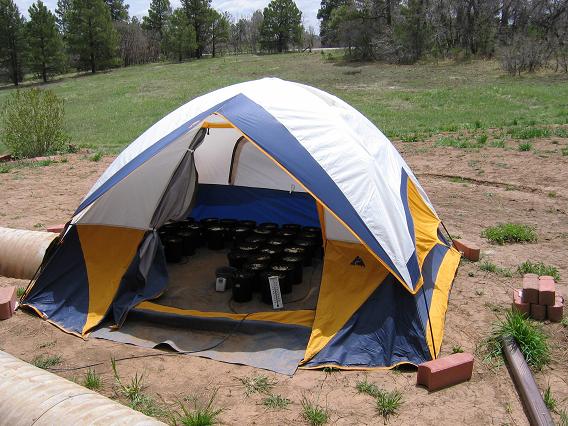 The picture to the right shows the
white, yellow, and blue temporary “greenhouse”. The Welker trees
(see below) were subsequently planted in the open meadow in the
background. A significant number of the seedling crop will also be
eventually planted in the same meadow.
The picture to the right shows the
white, yellow, and blue temporary “greenhouse”. The Welker trees
(see below) were subsequently planted in the open meadow in the
background. A significant number of the seedling crop will also be
eventually planted in the same meadow.May 4, 2008
Last 4 of Berg’s seeds planted. Rest of seeds discarded. Total germination was 36 out of 83 for “Grow your own” and 38 out of 100 for Berg’s. Most seedlings moved to camping tent today. Have “heat tape” wound through pots in tent ready to plug in for cold nights.
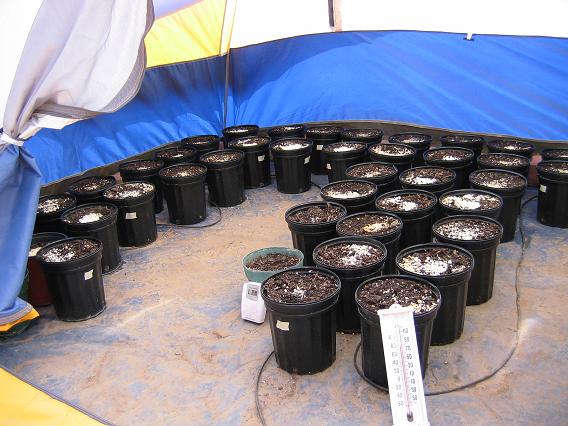
As seedlings break the surface, I moved them outdoors into an ordinary 8’ x 9’ (yellow, blue, and white) camping tent. Tent provided shading from direct sun, protects them from late frosts, and has easy access and ventilation. Tent is in full sunlight, has open mesh top (but with cover) with door to north - open during daylight hours. May temperatures are frequently near freezing at night.
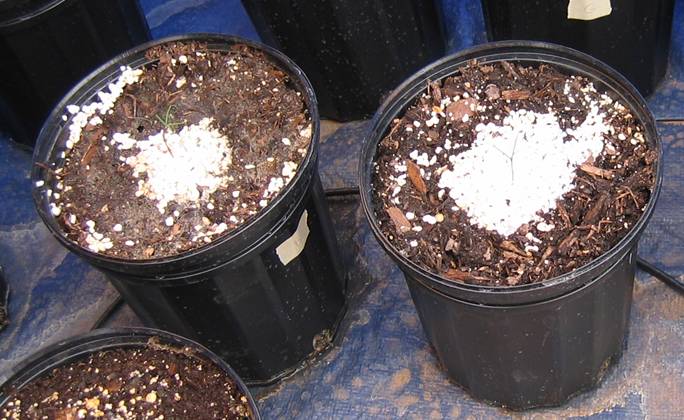
May 17, 2008
As of this date there were 68 seedlings growing in the tent.
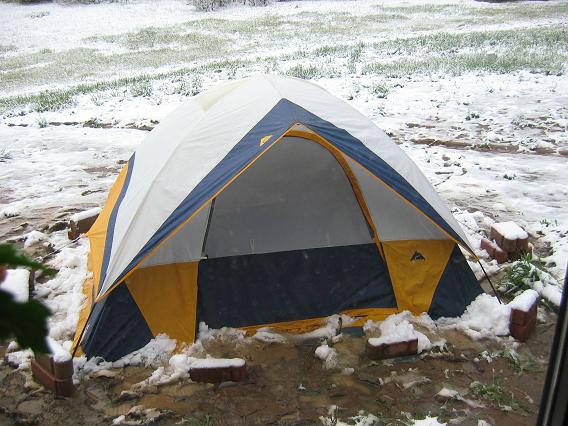
May 23/24, 2008
The tent partially collapsed from 3.6 inches of wet snow. It would have totally collapsed if I hadn’t placed two card tables inside the tent earlier in anticipation of snow. At first glance all 68 seedlings look OK.
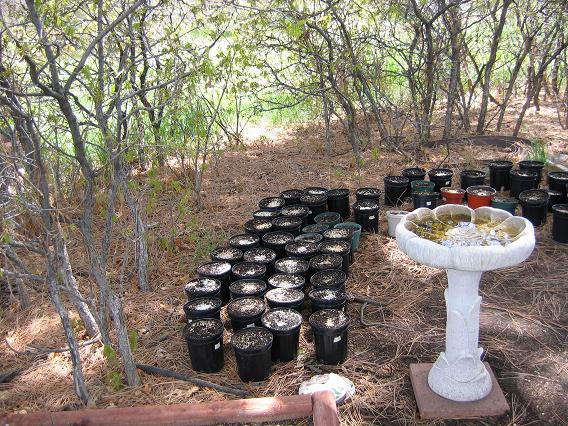
May 25, 2008
Seedlings/pots moved from tent to underneath a pine tree. (Gamble Oak is next to seedlings.) Tent cleaned and stored for future use.
May 26, 2008
Left for vacation trip. A neighbor (Carrie Slifka) watered seedlings while I was away.
June 23, 2008
Returned from vacation trip. Seedlings are in pretty good shape - moved them out into brighter light but still lightly shaded.
June 25, 2008
Ordered two premium Giant Sequoias from Welker’s Grove Nursery. http://www.giant-sequoia.com/homepage/ Trees are 3 years old, which means I’ll have something of reasonable size 3 years sooner than what I’ll get from the seeds. (Joe Welker/Welker’s Grove Nursery also sells via eBay at http://search.ebay.com/_W0QQsassZkylerkris )
June 30, 2008
Giant Sequoias are shipped from Welker’s Grove Nursery via Priority Mail.
July 3, 2008
Giant Sequoias arrive. Shipping box was beaten-up “a bit”. Each Giant Sequoia had a support stake, but one support stake was completely broken and the other was badly splintered but still in one piece. Giant Sequoias are OK. Moved Giant Sequoias outside to light shade area next to seedlings. (They were in a dark box for at least 3 days, and the idea was to let them gradually get used to light again.) Replaced broken support stakes with “tomato support stakes”.
July 4, 2008
Started preparation of planting sites for Welker's two Giant Sequoias. Each will be planted in a nest/basin. The soil immediately outside the root-ball area will be potting soil. Then a ~1.5 foot radius will consist of the following layers. (from the undisturbed ground on up) Potting soil, original dirt from nest/basin excavation, thin plastic layer using plastic trash bags (liberally punctured to let rain through), a thin layer of gravel, and finally a Red Cedar bark mulch on top. The idea is to favor root growth several inches below the surface, and let rain water in but retard surface evaporation.
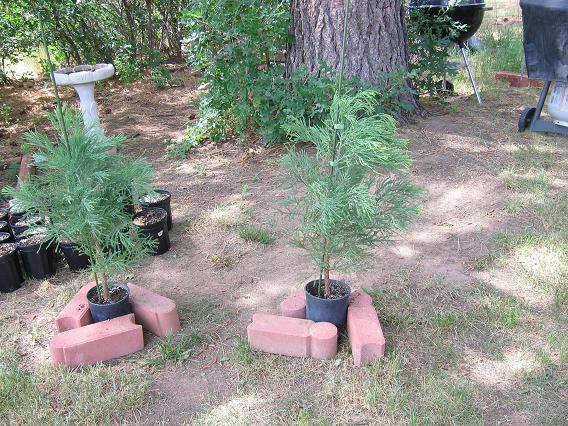
July 5, 2008
Took photos of the Giant Sequoias. Giant Sequoias from Welker’s Nursery are 3-years old (2005 seedlings) and about 30 inches high. Moved the two Giant Sequoias to sunnier area. (Welker’s Grove Nursery is highly recommended for the quality of the trees, speedy shipping, reasonable price, etc.)
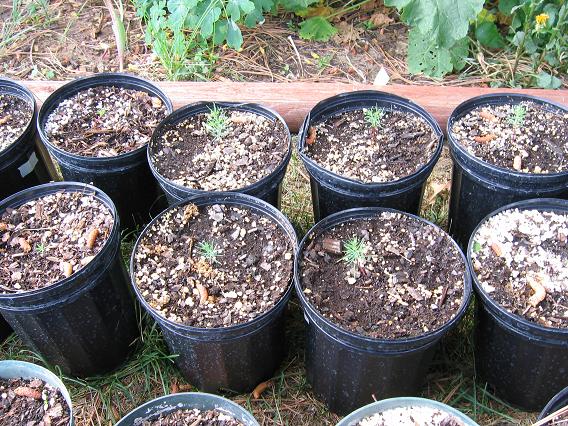
Fastest growing seedlings are about 2 inches high with some already developing branches. Total surviving seedling count is 65. I expect that some of the “runts” won’t make it. The “white stuff” on the soil surface is particles of Perlite which by now have been well scattered by periodic watering.
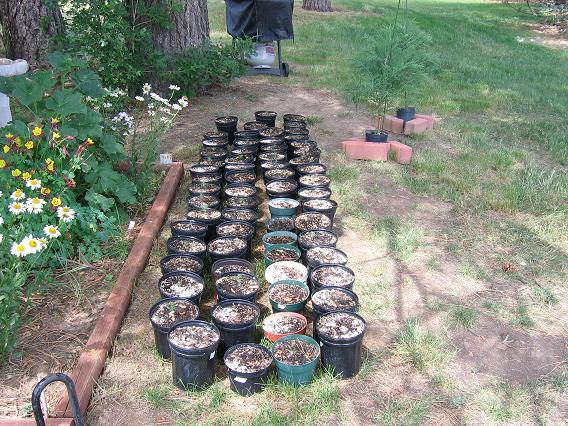
The above photo shows the entire inventory of Giant Sequoia trees as of July 5, 2008. The seedlings are gradually being moved into greater sunshine.
July 7, 2008
Late this afternoon I planted the two Giant Sequoias that came from Welker’s Grove Nursery. http://www.giant-sequoia.com/homepage/ The diagram below is a schematic diagram of how they were planted. Thoroughly soaked each tree immediately after all layers were complete.
G
I
A
N
T
Tree branches
S
E
Q
Tree branches U Tree branches
O
Rim for nest/basin I Rim for nest/basin
Rim for nest/basin A Rim for nest/basin
Undisturbed ground Mulch Potting Original Potting Mulch Undisturbed ground
/|\ Gravel soil root soil Gravel /|\
| Film Potting ball Potting Film |
| Loose dirt soil (came) soil Loose dirt |
Undisturbed Loose dirt P.S. (from) P.S. Loose dirt Undisturbed
ground Potting soil (pot) Potting soil ground
| <- - - - - - - - Potting soil - - - - - - - - - -> |
\|/ <- - - - - - - - Potting soil - - - - - - - - - -> \|/
<- - - - - - - - - - - - - - - - - Undisturbed ground - - - - - - - - - - - - - - - - ->
<- - - - - - - - - - - - - - - - - Undisturbed ground - - - - - - - - - - - - - - - - ->
The rim was constructed so that buckets of water could be poured into the nest/basin, and it would all have to soak down into the soil around the tree. Diameter of rim was about 5 feet.
Mulch = Red Cedar mulch
Gravel = A thin layer of loose stones/gravel
Film = A plastic film from an ordinary trash bag with many slits cut into it. The idea is to let rain water through but to block evaporation from the ground underneath.
Loose dirt = Dirt that was excavated to make the nest/basin and then replaced. The plan is to encourage the tree to develop its root system just under this layer.
Potting soil = This is the zone where the tree should develop its root system - especially the layer several inches down under the loose dirt layer.

July 8, 2008
Took photos of the Giant Sequoias in their new home - to record “The early days”. The Giant Sequoia to the east of the house is about 29 ½ inches tall while the Giant Sequoia to the south of the house is about 30 ½ inches tall. Each day (or every other day at worst) each Giant Sequoia got a bucket (2 gallons) of water. (Thirsty little monsters.) Drainage is not a problem as each is on slope.
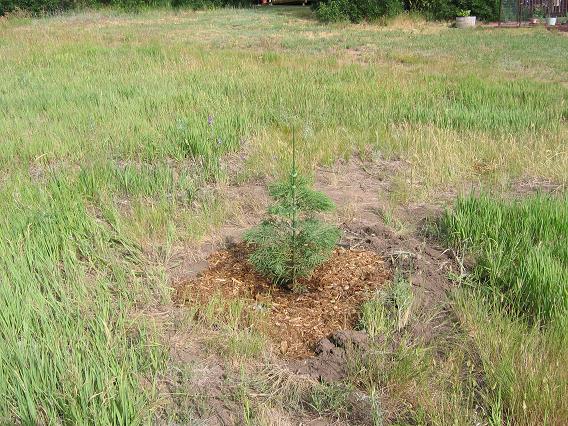
July 15, 2008
Warm weather fertilization plan. Every 2nd week (1st and 15th of each month), each Giant Sequoia will be fertilized using the following mixture. Add one tablespoon of regular Miracle-Gro (24-8-16) and one tablespoon of Miracle-Gro for acid loving plants* (30-10-10) to a two gallon bucket of water. Each Giant Sequoia gets a full bucket. (Alternately, two tablespoons per bucket of Miracle-Gro Evergreen Tree & Shrub Food (28-10-10) should work just as well.) They got their first dose today. First fertilizer application (each year) will be June 1. Last fertilizer application (each year) will be Aug. 1. (Cut-off date will let trees start getting ready for winter dormancy.) One’s imagination sometimes gets carried away as Scotts Miracle-Gro advertises: “Grow plants twice as big!” (As trees grow larger in the future they will get multiple buckets, but after 5 years or so they will have to make it on their own.)
*Actual ingredient used was Miracid which is the old name for Miracle-Gro for acid loving plants. The ingredients (including acidic content) are identical and Miracle-Gro recommended Miracid for “all evergreens”.
Both Giant Sequoias have grown about an inch, and both have many new shoots beginning to grow - including from the main trunk just above ground level. Overall they look “happy”.
Aug. 10, 2008
Won an eBay auction for another 3-year old Giant Sequoia from Welker’s Grove Nursery. The two earlier trees from Welker continue to look healthy. One of them had a double top. (Right tree in the first Welker photo.) One of these tops was clipped off and currently is in a pot in an attempt to root it. The seedlings (see photo below) are separating into groups of fast growers (3 to 4 inches high), slow growers, others that probably won’t make it, and casualties. (Casualties include several that deer sampled before they concluded they weren’t too enthused about them. There have been several recent mountain lion sightings within a few miles - including in downtown Durango. I may start rooting for the cats as they prey on deer.)
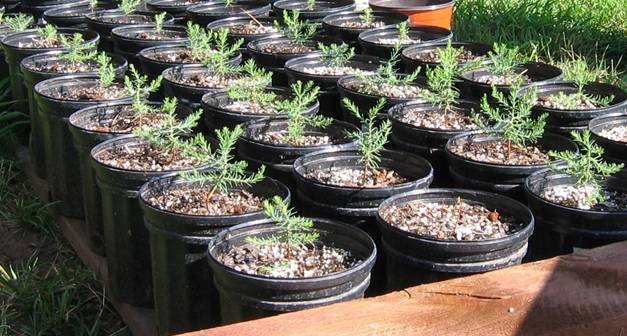
The above photo shows the fastest
growing seedlings as of Aug. 16, 2008.
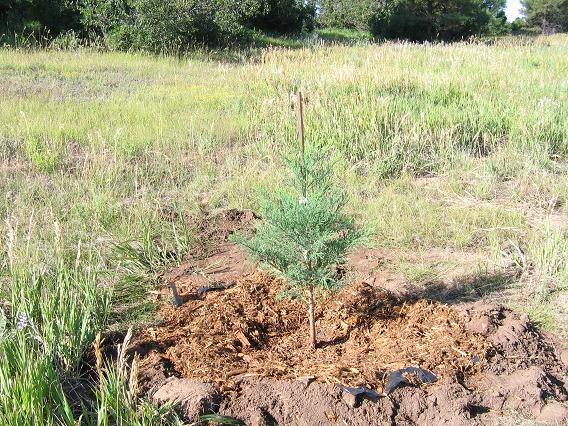 Aug. 16, 2008
Aug. 16, 2008The new 36-inch tall Welker tree was shipped on Aug. 11, 2008 and arrived late on Aug. 14. As per usual with Welker’s Grove Nursery, it’s a great looking tree and arrived in good shape. (e. g. Rootball still was still damp.) It was thoroughly watered and given mostly shade on Aug. 15 (to recover gradually from a dark box), and about 5 hours of direct sunlight on Aug. 16. Late on the 16th it was planted in an area that gets full sunlight. Planting methodology was similar to the earlier trees except I didn’t bother with the gravel layer.
The first two Welker trees appear happy in their new home. They have grown a few inches vertically, have active growth on all branches, and even have large numbers of new shoots sprouting from the trunk as low as two inches above the soil level. So far there’s minimal if any “brownout” on the older branches/trunk, but brownout is expected to begin in the not too distant future as nighttime temperatures are already dipping into the 40s.
The trees were subjected to their first hailstorm today with brief hail to 5/8 inch diameter. A couple of small twigs were broken off the first two Welker trees, and one of the seedlings was split. Overall, they faired pretty well. The new Welker tree hadn’t been planted yet, and the author dashed outside to move it under cover before the larger hailstones fell. They will have to get use to occasion hail storms as the local area tends to be “hail city”.
Oct. 13, 2008
55 of the original seedlings are still growing in pots although growth has stopped for the year. They are currently back in the tent undergoing a gradual winterization. (On cold nights the tent is covered with a tarp and the heat tape is plugged in.) Their temperature environment will be gradually reduced to the 35 to 45 degree range, and about Nov.1 they will be moved into the garage for the winter. They will be placed in a sheltered area, and the heat tape (see tent, above) will be used to keep them slightly above freezing. (Temperature will be monitored.) A “grow light” will be used for minimal lighting (normal daylight hours - via a timer), and they will be watered occasionally just so they don’t dry out.
The three 3-year old trees from Welker will of course have to spend the winter outside. “Tomato/plant stakes” have been inserted around the periphery of each tree, and eventually plastic trash bags will be placed over the stakes (and tree) to help protect the trees from cold winds and heavy winter snow. The north side of each bag will be left open. The purpose will be to prevent the trees from being bent by winter snow and shade them from winter sunshine. (Note: A completely closed bag could get too warm during daylight hours.)
Also, the ground within a 2 foot radius of the trees has be protected from early winter cold by covering it with cut branches from a large Juniper bush. (The temperature on Oct. 13 got down to 15 degrees.) It’s a long winter here, and the ground on shaded north-facing slopes usually freezes about the first week in November. (The Juniper bush is actually an “ugly”, nondescript looking bush, and the @#$%^&* thing needed major trimming anyway.)
The 3 Welker trees still look healthy although they are not as bright a green as they were during warmer weather. So far there hasn’t been any winter discoloration (brown, red, purple colors) although this may show up later.
Finally, a year ago, my wife bought a seed package with a mixture of Giant Sequoia and Coast Redwoods seeds. She hasn’t done anything with it and has said that I can use it. I don’t have much hope for the Coast Redwood seeds (Coast Redwoods couldn’t survive in the local climate), but will run another stratification/germination sequence for these seeds this winter to see what happens.
Nov. 10, 2008
First significant snow - about 5 inches. The 55 Giant Sequoia seedlings are safe and sound for the winter in a sheltered area under a stairway adjacent to the garage. They are in their own private indoor greenhouse completely enclosed by a tarp. (Perhaps “bluehouse” might be a better name.) In any case their temperature will be held in the 35 to 45 degree range for the winter. They get several hours of artificial light per day (controlled by a timer), and the heat tape is wound around/through them if/when it starts to get too cold. They will need water about every 2 weeks through the winter, but will be checked weekly.
The three (outdoor) Welker trees have been mulched for the winter. They have a slight browning on their south and southwest sides due to a combination of sunshine, our normal low humidity, and several nights of temperatures that have already hit the single digits. Overall they appear to be in pretty good shape. The snow arrived sooner than expected so I haven’t put up their “trash bag roofs” yet (see above), but I’ll have these in place before full winter sets in.
The Sad Ending
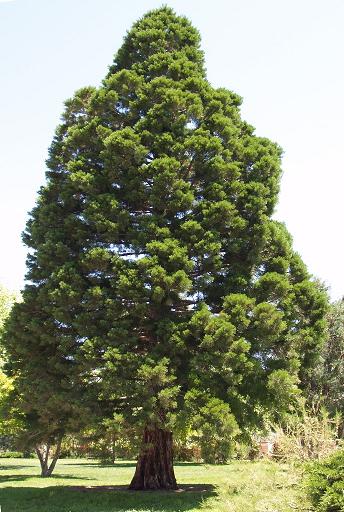 The Giant Sequoia tree
shown to the right is growing in a park in Santa Fe, New Mexico.
It is an example of what might have been. The original photo along
with a reader’s comment of “What a whopper!! Beautiful tree” can
be seen at http://www.flickr.com/photos/gnarlodious/2344307375/
The Giant Sequoia tree
shown to the right is growing in a park in Santa Fe, New Mexico.
It is an example of what might have been. The original photo along
with a reader’s comment of “What a whopper!! Beautiful tree” can
be seen at http://www.flickr.com/photos/gnarlodious/2344307375/The local district board (Durango West II Metro District) has informed me that I must remove the Giant Sequoia trees as they are “non-native”. Since they were planted in our local “Green Belt” and not on my property, I of course have complied.
A quote from a representative from the Arbor Day Foundation. (The ADF is the organization that awards “Tree City USA” certifications.)
“Sequoias are native to the USA and to say that they're not native to this tiny corner of Colorado is uninformed. There are non-native trees which don't belong in Colorado forests, that's for sure. But these are from China or invasive or otherwise dangerous to the existing eco-system.”
It is my opinion that a small local grove of Giant Sequoia trees would have added to local property values within our development. Sequoias are unique. They designate national parks (also state parks) for them. It seems reasonable that a local grove of Giant Sequoias would have enhanced the desirability of living in our development. Thus the banning of the Giant Sequoia trees by the Durango West II district board may have depreciated real estate prices from what might have been.
It is also my opinion that the biodiversity of having Giant Sequoia trees would have added an insurance policy that would increase the probability that we would still have green trees in case our local Ponderosa Pine trees were wiped out in a beetle attack. There is a case study of exactly this happening.
A Los Angeles Times newspaper article (“A Lofty Plan to Reforest” http://articles.latimes.com/2003/dec/28/local/me-trees28 ) describes what happened after a “bark beetle” attack wiped out the Ponderosa Pine trees in the San Bernardino Mountains. After much controversy, the local residents decided to reforest the area with something with properties that were “drought-, bark beetle-, ozone- and fire-resistant, grow three feet a year, and live thousands of years”. The local Masonic Lodge brought in 30,000 Giant Sequoia seedlings for the reforestation project. Think of the green trees they would have had if they had started the Giant Sequoias 20 years before they “were hit hard by wave after wave of bark beetles”.
Added Jan. 26, 2009
The potential threat of a bark beetle attack that could kill most of our existing Ponderosa Pine trees was outlined at http://www.sciencedaily.com/releases/2009/01/090122141222.htm
along with related news stories in many newspapers.
“A new study led by the U.S.
Geological Survey and involving the University of Colorado at
Boulder and Oregon State University as well as other research
institutes indicates tree deaths in the West's old-growth
forests have more than doubled in recent decades, likely from
regional warming and related drought conditions.”
“The increase in tree mortality rates documented in the study is further compelling evidence of ecosystem responses to recent climate warming,” said Veblen. “The findings are consistent with other well documented, climate-induced ecological changes, including increased wildfire activity since the mid-1980s and bark beetle outbreaks that are occurring at unprecedented levels in western North America forests, including Alaska.”
“The increase in tree mortality rates documented in the study is further compelling evidence of ecosystem responses to recent climate warming,” said Veblen. “The findings are consistent with other well documented, climate-induced ecological changes, including increased wildfire activity since the mid-1980s and bark beetle outbreaks that are occurring at unprecedented levels in western North America forests, including Alaska.”
Winter 2008/2009
The three Welker trees were dug up and placed in large pots. One of them was given to a friend (a “master gardener”) who will plant and take care of it, so it’s in good hands. The two other Welker trees and the crop of seedlings were moved to a small area under a stairway off the garage. A makeshift “greenhouse/tent” was set up using assorted trash cans, pieces of lumber, lawn tools/furniture, etc. with an ordinary tarp covering the sides and top. All the trees were moved inside along with a couple of table lamps that were hooked up to a timer to provide several hours of light per day. Finally, the 60-foot-long gutter heat-tape was wound among the pots to provide heat if/when as needed. A remote thermometer was used to keep track of the temperature.
Thus the entire crop spent the winter at about 40 to 45 degrees. The seedlings had been green all along as they had been sheltered from freezing weather. The two remaining large trees had turned moderately brown from cold weather before they were dug up. Over the course of the winter they gradually turned back green again.
Spring 2009
About late April the tent was set up again and the two remaining Welker trees and the crop of seedlings were moved outdoors. Once again, the heat tape was wound around the inside of the tent for use on cold nights. (The tarp was also used as an extra cover over the tent on cold nights.) The two large trees and most of the seedling crop survived the winter in good shape.
Of the two remaining large trees one was subsequently given away to another friend. She is an “avid learner” and I helped her plant the tree. It is also in good hands.
The Last Welker
Tree
The last of the three Welker trees was replanted the first week in June. This time it is on private land and hopefully it will have a chance to live long and prosper.
The Giant Sequoia Tree shown below is the same tree that was pictured earlier just above the July 8, 2008 label. Over the last year, the tree has endured:
1) Packaged in a carton and shipped nearly 1,000 miles from California.
2) Beaten up en route so that the support stake was broken.
3) Taken out of its home (the original pot) and planted.
4) Dug up and placed back in a large pot for the winter.
5) Replanted again. (Similar planting technique to the earlier description)
The good news - compare what it looks like now (below) vs. what it looked like a year ago. (The earlier July 8, 2008 photo)
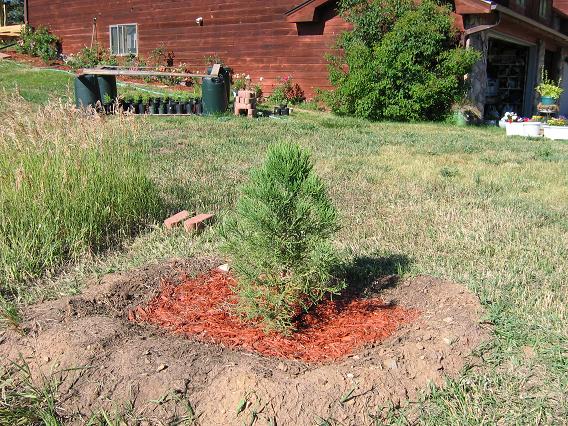
The above photo shows the last of the Welker trees as of July 15, 2009. So far “the world’s most pampered Giant Sequoia” has 7 inches (and counting) of new growth this year. The branches have filled in considerably since a year ago. The trunk is an inch and a quarter in diameter and beginning to look like a “Louisville Slugger” - including new branches that keep popping out all the way down to ground level.
In addition to being watered frequently, it gets fertilized every two weeks according to the fertilization schedule given earlier. I have great hopes that this will become a “Legacy Tree”, and will update this page from time to time in the future.
There is still one big test to go. It will have to spend this next winter outdoors. I will be putting something around its base to help protect its roots from freezing, but it’s a forgone conclusion that the top portion of the tree will turn brown from the cold. The big test will come about next April/May.
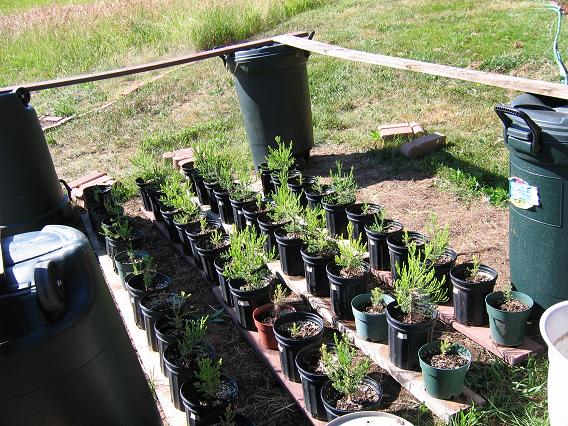
The picture above shows the seedling crop as of July 2009. (The makeshift barrier is to discourage deer.) A few more seedlings from the original crop have died off over the last several months, some are alive but are obvious runts, and others are growing rapidly. I haven’t any plans yet as to what I will do with them, but they will have to spend the next winter inside similar to the way they spent last winter.
Disaster
On the night of Oct. 22, 2009 a male (buck) deer used what had been a very vigorously growing tree as a “scratching post”. While deer rarely eat the foliage of a Giant Sequoia tree due the prickly nature of the leaves, it appears that in the fall (rutting season) male deer will rub their antlers against the trunk of small tree to remove velvet from their antlers.
The last of the Welker trees, which over the summer had grown well over a foot and had added nearly an inch to its trunk diameter, has suffered severe damage from such an attack. Over one half of the branches have been broken off. Worse yet, a large amount of bark has been scraped off including about a four inch portion where the bark has been removed all the way around the tree. (Completely girdled)
While I have tried to patch the tree as best as possible using tree wound paste and banding material, there is little chance the top half of the tree can survive. There is a reasonable chance that surviving branches near the base can take over and eventually start a new main trunk. However, even if the tree can recover, it may look more like a Giant Sequoia “bush” until a new trunk can take over.
If you live in an area that is populated by deer, an ounce of prevention may very well save your tree from similar damage. Put some kind of fence around the tree that is strong enough to prevent male deer from reaching the tree.
I still have a large number of potted seedlings with many of them now over a foot high. I’ll try planting a couple of these next year followed by planting the rest in 2011. Thus I’ll be continuing the experiment to see if Giant Sequoias can grow in our local climate.
Two days later, a buck deer was killed in a car-deer collision on U. S. highway 160 (65 MPH speed limit) just a few hundred yards from the author’s home - which appears to close out the deer’s portion of the story.
Winter 2009/2010
A couple of days after the “Deer Disaster” I bought a small roll of 48-inch high welded wire fence and support stakes at a local farmers coop supply. These were used to construct a 5-foot diameter fence around the tree with one end of the wire only loosely fastened to complete the circumference. (This allows easy access for weeding, etc.).
In mid November, a temporary insulating layer of tree-branch mulch and pieces of tarp were spread around the base of the tree to protect the root system from early cold weather. (These will be removed in the spring.) The first big snow fell on Dec. 8, 2009, and there has been over one foot of snow on the ground for the rest of the winter. By late January even the battered top of the tree was buried, and it’s still buried as of late Feb. (Snow depth peaked at over 4 feet - but this is normal for Giant Sequoias’ native growing area in the Sierras.) It’s most unlikely that the top of the tree will survive, but the lowest 15 inches of the tree and the root system were not damaged. When spring finally gets here, it’s highly probable that it will be able to start over again.
Meanwhile, the seedlings have been “enjoying” another winter in the garage in their own private storage area. A tarp has been used for a makeshift tent. Ordinary gutter heat tape is wound through the array of pots and turned on whenever the temperature in the storage area threatens to go below 40 deg. Ordinary table lamps have been hooked up with a timer to give them a few hours of light per day. Finally, they are watered every few weeks just so they don’t dry out. As of late Feb., I still have more healthy looking seedlings than I have room to plant them. I’ll give most of them away when they are ready to plant.
Spring 2010
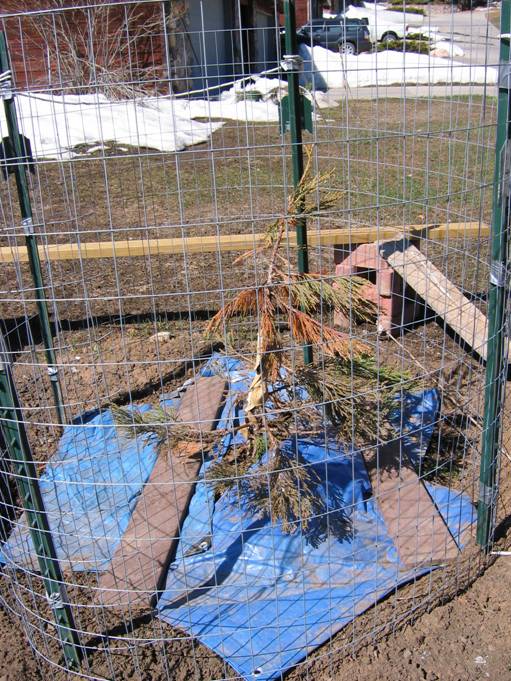
The photo above was taken April 8, 2010 and shows what is left of the tree after the deer attack and a long winter buried by snow. As of May 21, there appears to be little hope that the top 2/3 of the tree will survive. I’ll wait another couple of weeks just in case before trimming off the dead portions.
The base of the tree spent the winter under layers of mulch, small tarps, and a couple of boards to hold the tarps in place. When these were removed there were new green shoots growing from the lower trunk. It also looks like a couple of the lowest branches that are visible in the photo are also going to make it. Thus it looks like the tree will survive to try again, but for a couple of years it’s going to look more like a Giant Sequoia bush as opposed to a Giant Sequoia tree.
The seedling crop was in a sheltered area in the basement over the winter and has been moved back outdoors to the tent for a few more weeks of partial shelter. About two dozen of the seedlings are 10 to 16 inches high and look like they are ready to start growing vigorously as soon as the weather warms a little more. (We still are having frosts as of late May.) Another two dozen aren’t quite as high, but look like they will make it OK too. Finally, there are several stragglers that may or may not make it, but I’ll be giving them a chance as long as they have some green.
June 8, 2010
Update
The top 2/3 of the Welker tree never showed any signs of life and unfortunately had to be trimmed off. The good news is that the bottom 1/3 is not only surviving but growing vigorously as if to make up the difference. There are many new shoots growing from the trunk as well as from the surviving branches. It will take a year or two before one of these shoots takes over as a new trunk (with maybe some pruning help), but it looks like it may regain a name of “Giant Sequoia Tree” as opposed to “Crippled Sequoia Tree”.
The seedling crop is also thriving. The more rapidly growing seedlings already have an inch of new growth. They are getting full sunshine, I’ll start their fertilizer routine in a few days, and most importantly, they get lots of water. (If you are growing Giant Sequoias in pots, make sure they don’t dry out as potted plants can dry out very quickly.)
Sept. 4, 2010
Update
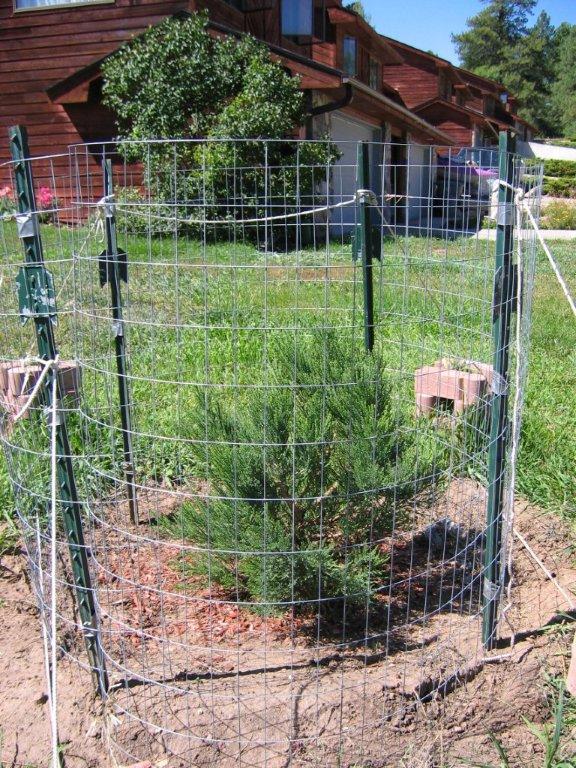
The picture above shows the Giant Sequoia “Deer” Tree after it’s had a chance to recover. The photo location and view direction are similar to the April 2010 picture. Several branches have grown over a foot with a couple of these trimmed back to help the shape of the tree. More importantly, one of the new sprouts that started directly from the top of the cut-off trunk has grown over a foot since April. This new spire looks like it will take over as the new trunk. It will take another year for the tree to regain its former height, but at the rate that it is growing, it won’t take more than half a dozen years or so before it’s 10 or more feet high.
The fence is somewhat of an eyesore, but it will have to stay put until the tree trunk is large enough so that deer will ignore it. This will probably take about the same half dozen years.
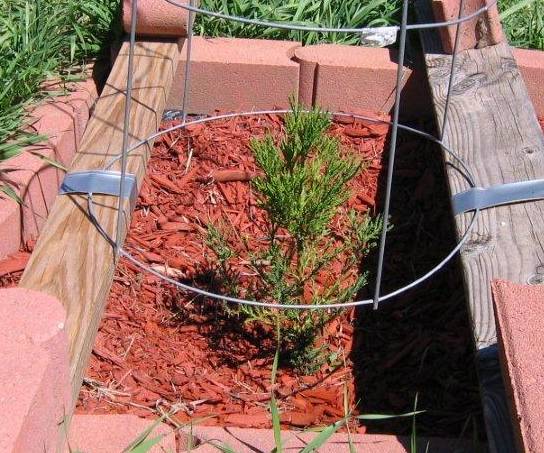
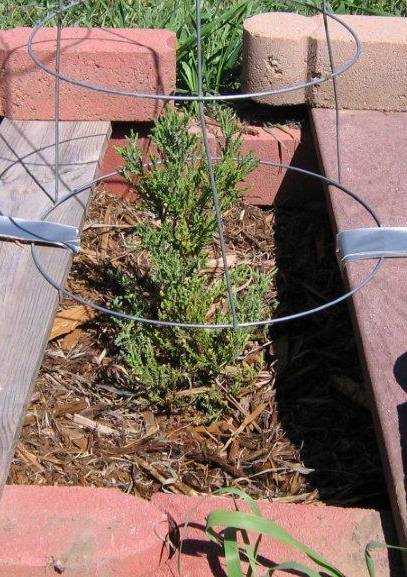 Meanwhile the seedling
crop continues to grow, and four of them have been planted
outdoors. Planting technique was similar to the diagrams that I
gave earlier except I ignored the gravel bit. Ordinary mulch
spread directly on top of the plastic garbage bags seems to work
fine.
Meanwhile the seedling
crop continues to grow, and four of them have been planted
outdoors. Planting technique was similar to the diagrams that I
gave earlier except I ignored the gravel bit. Ordinary mulch
spread directly on top of the plastic garbage bags seems to work
fine.Two of these seedlings are shown in the photographs. The boards on either side of the trees are just temporary anchors for upside-down tomato cages. (Deer won’t eat the leaves because they are prickly, but the tomato cages will prevent them from poking their antlers thru. Late this fall I will be removing the tomato cages and placing large pots upside-down over the seedlings. Then they will get further protection – especially over their root systems to insulate them from cold weather (and drying sunshine) before they are buried by winter snows.
I will be experimenting with another G. S. seedling as a “house plant” just to see what happens. Giant Sequoias usually aren’t considered as “house plants”, but I’ve still got 35 other seedlings to play with so I can try a few experiments. The rest of these 35 seedlings will be kept in the garage for the winter. (Similar to last year.)
One item of note if you are growing Giant Sequoias in pots. Earlier this summer, the seedling crop was kept on the (sunny) deck. The dark pots got quite warm in the sunshine, and I suspect that the combination of heat and the moist soil led to fungus infections in the potted soil. I sprayed them with an ordinary fungicide and moved them so they wouldn’t get as hot. The seedling crop seems to be fine now, but it’s something to keep in mind if you are growing Giant Sequoias from seed.
As a rough rule of thumb, if you are growing Giant Sequoias in pots, try to keep the soil temperature below 80 deg. F. If the soil temperature goes above 90 deg. F, the combination of the warm temperature and moist soil is asking for fungus problems. If you have Giant Sequoias in pots and the pots feel warm, temporarily move them to a lightly shaded area.
As of Sept. 12th, we’ve already had our first light frost. All of the planted Sequoias have continued to grow up to now, but from here on they will be getting ready for winter. Also, the third of the original Welker trees (the 36-inch tree) has been returned to me and is a very sick puppy. It was still in the original pot and looks like it had been sitting in water (in a large saucer) to the point where most of the roots have died. All of the branches have died, but after I had a chance to dry it out and replace some of the rotted soil in the pot, it looks like its trying to grow new sprouts from its trunk. I’ll keep it inside over the winter to try and nurse it back to health. (The other original Welker tree that I gave away was properly planted and looks like it is doing OK as of a recent check.)
Nov. 28, 2010
Update
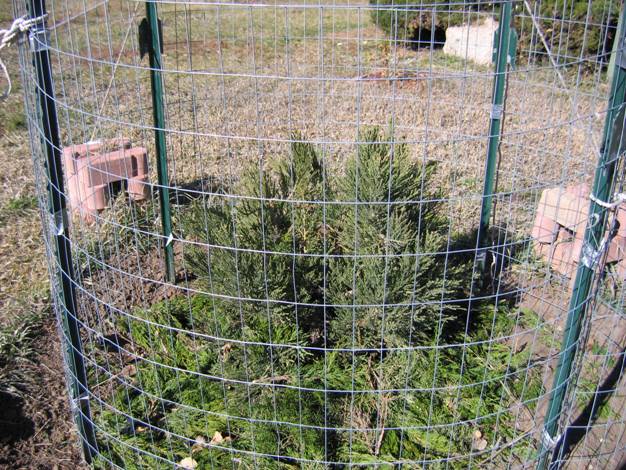
The picture above shows the “Deer” tree as of mid Nov. 2010. The new central shoot (which will become the new trunk) grew another couple of inches after the Sept. photo before it settled down for the winter.
The light green stem near the center of the upper growth is the “new trunk”. Some of the outer branches were trimmed back to make sure the central shoot will have a clear space to grow. Several of these cuttings have been successfully rooted and will be grown indoors this winter.
Several inches of trimmings from the Juniper bush (lighter green) have been spread around the base to protect the root system from early winter cold temperatures. The first light snows have fallen as of Nov. 28, and the ground should be covered for the winter by mid Dec.
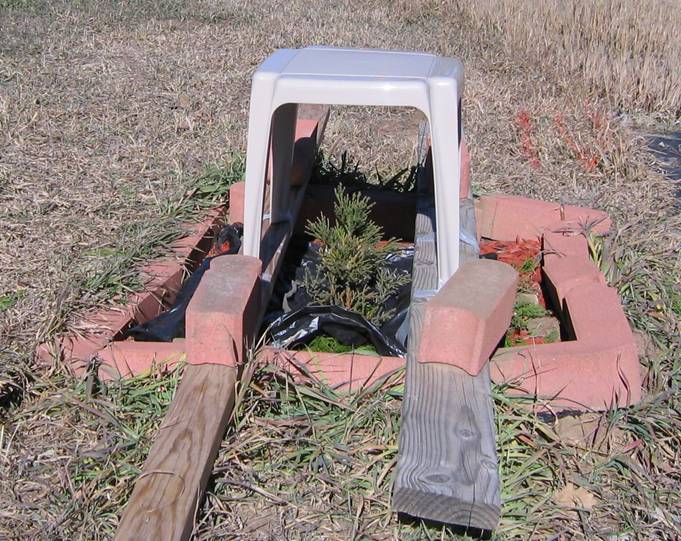
The 4 planted seedlings are getting their share of “pampered” treatment for the winter. The picture above shows one of these. (Same tree as the first seedling photo in the Sept. 4, 2010 update.) Each of the 4 seedlings has several inches of Juniper branches for mulch followed by a plastic garbage bag to cover this temporary mulch. Finally, each has a plastic end table (deck furniture) for a “snow umbrella”.
Last winter we had 14 feet of total snow with a maximum depth of 52 inches. Young Giant Sequoias are very flexible, but the snow umbrellas should prevent any possible squashing of the trees.
There are still some 3 dozen Giant Sequoia seedlings that are in pots. Several of these will be grown indoors over the winter - similar to ordinary house plants. The rest have been stored in the garage as per last year.
Finally, the Sept. 4th update mentioned one of the original Welker trees that had been returned to me. At one time it looked like some of the small sprouts might have a chance for the tree to start over again, but it never made it. The roots were hopelessly rotted with a disappointingly inevitable result.
July 4, 2011
Update
The 3 photos below show the late June 2011 status of the same 3 trees as shown in the Sept. 4, 2010 update. All 3 trees turned a greenish brown color over the winter. In late spring and early summer, last year’s growth returned to normal green colors as shown - along with rapid new growth. The only casualty was the new central shoot on the “Deer” tree. This “promising” central shoot died over the winter with the result that as of early summer there isn’t any apparent new “central shoot” to take over as a new main trunk.
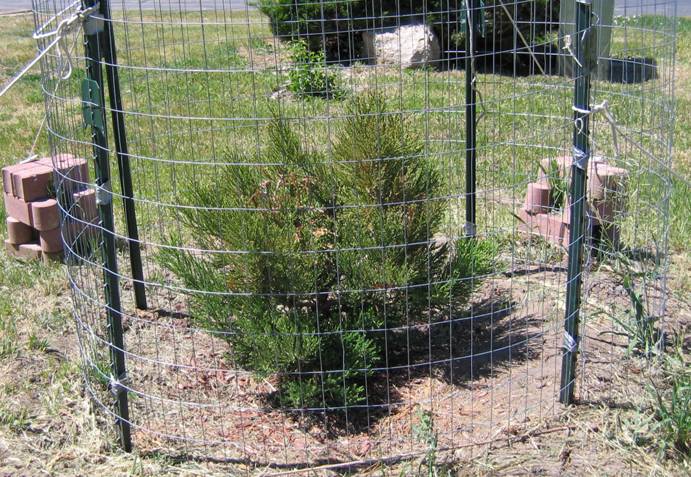
The photo above shows the “Deer” tree as of late June. (The photo was taken from a different direction than earlier photos of the “Deer” tree.) The only casualty of the winter was the new “central shoot”. As a result, it is still a Giant Sequoia “bush” until some other shoot tries to become a new main trunk.
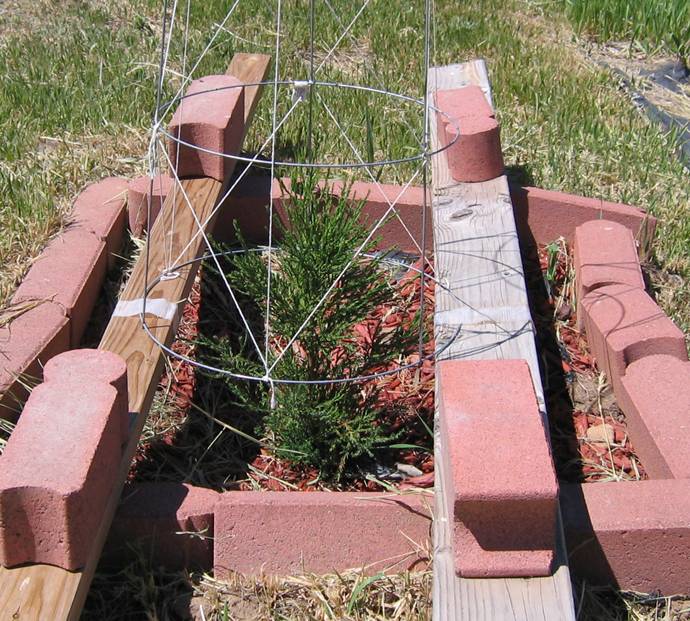
The photo above shows the first of the 2 seedlings shown in the Sept 4, 2010 update - but as of late June 2011. The seedling turned a mostly brown color over the winter, but then returned to a green color with warmer weather. It has already added several more inches of new growth.
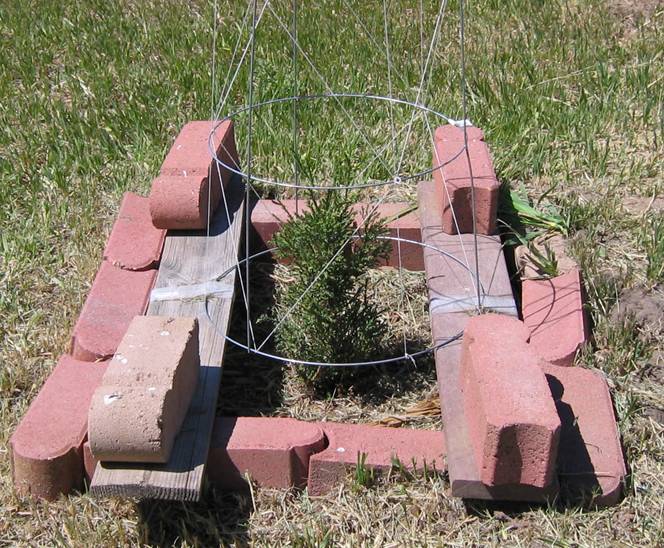
The photo above shows the 2nd of the 2 seedlings that were shown in the Sept. 4, 2010 update. Similar to the other trees, it turned a mostly brown color over the winter but returned to green with warmer weather. Just like the other trees, it is also growing rapidly again.
The other two planted trees have similar stories in that they turned brown over the winter, but are back to green and growing vigorously again.
Finally, I may be moving to a new home later this year. I still have a couple of dozen other seedlings from the original seeds plus cuttings from the “Deer” tree. They will be used to start another “mini grove”. The Giant Sequoias that have been featured on this page will have to make it on their own, but that is what the experiment has been all about since day 1.
December 3, 2011 Update
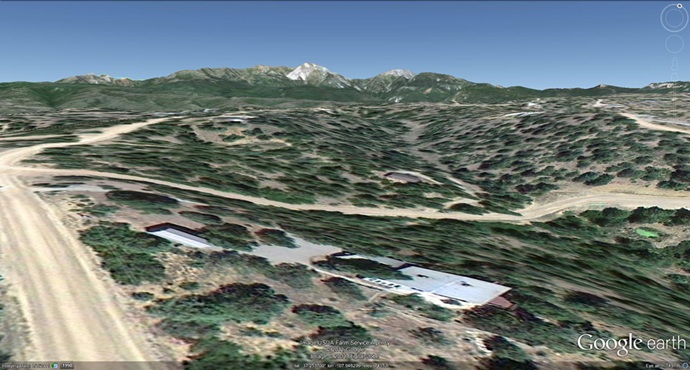
I have moved into my new home (Google Earth generated picture above) and left the planted Giant Sequoia trees at their old location as they were too big to dig up and move. As the photos below show, the planted trees are doing well. However, I have some 30 other trees that are a mix of the original seedlings plus rooted/potted cuttings from the planted trees. My new home has over 5 acres of land that is mostly a Ponderosa Pine Tree forest. Guess what is about to become Colorado’s 2nd Giant Sequoia grove?
The pictures below show the original Welker tree (deer damaged tree) plus all 4 of the planted seedlings as of Sept. 30, 2011.
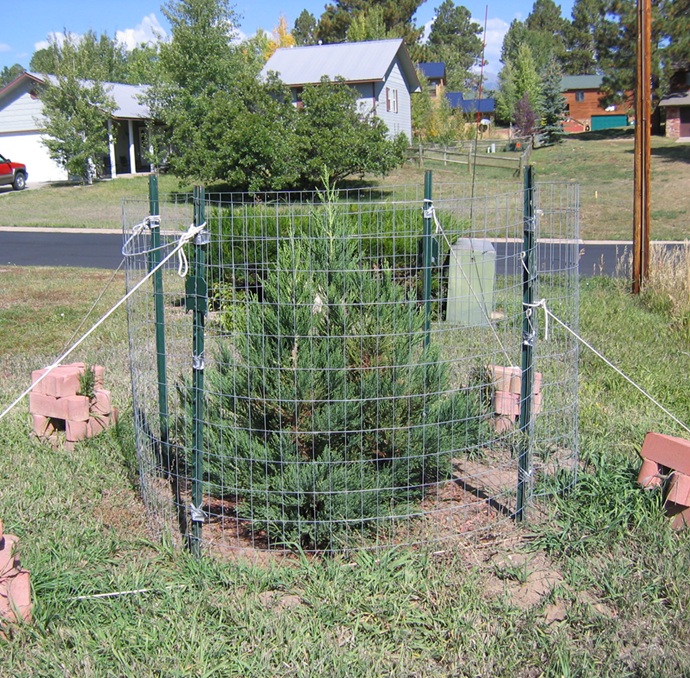
The picture above shows the “deer damaged” Welker Giant Sequoia tree. The top of the fence is exactly 4 feet above ground level. You can compare the tree's current status with the “Charlie Brown” status of the same tree as shown earlier in the “Spring 2010” section.
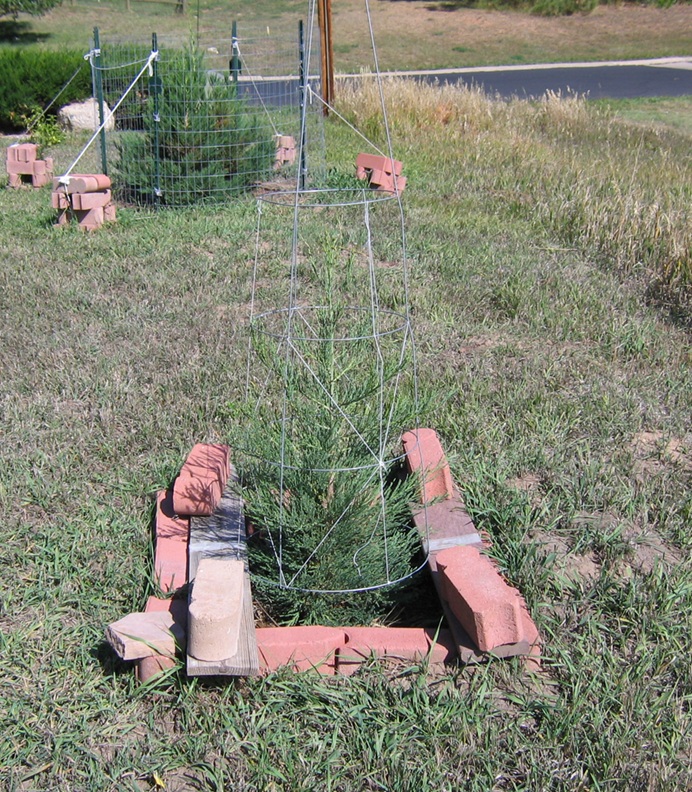
The picture above shows the status of one of the Giant Sequoia seedlings. The seedling is the same tree that can be seen in the last photo shown in the July 4, 2011 update. (The “Deer” tree can be seen in the background.) The circular rungs in the protecting tomato cage are 10 inches apart - which will give a pretty good idea as to how much the tree has grown in the last few months.
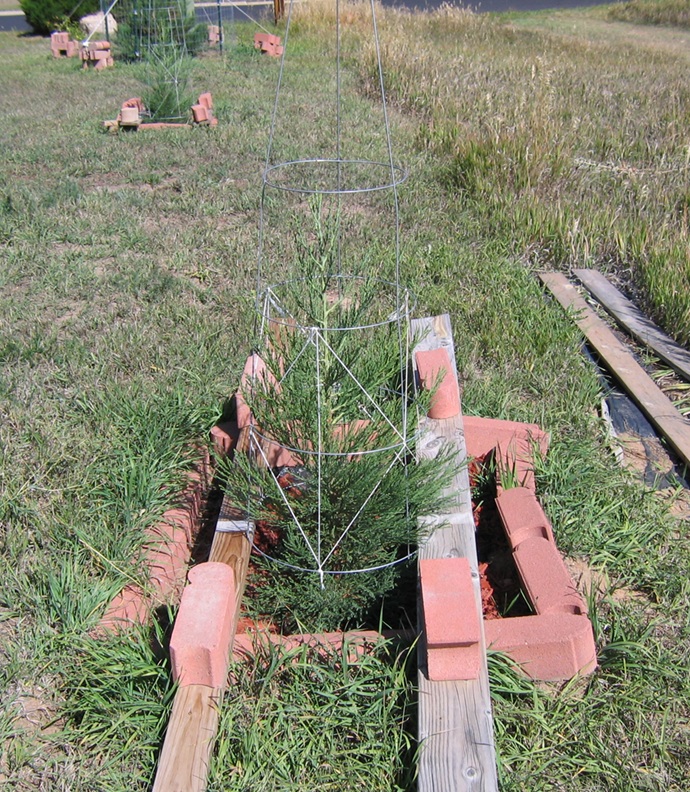
The picture above shows an update of the 2nd of the previously shown seedlings. It is the same tree that can be seen in the middle picture of the July 4, 2011 update. The “deer” tree and the other seedling (shown earlier) can be seen in the background.
I’ve previously mentioned that I had planted two other seedlings, but up to now, I haven’t shown any pictures of them.
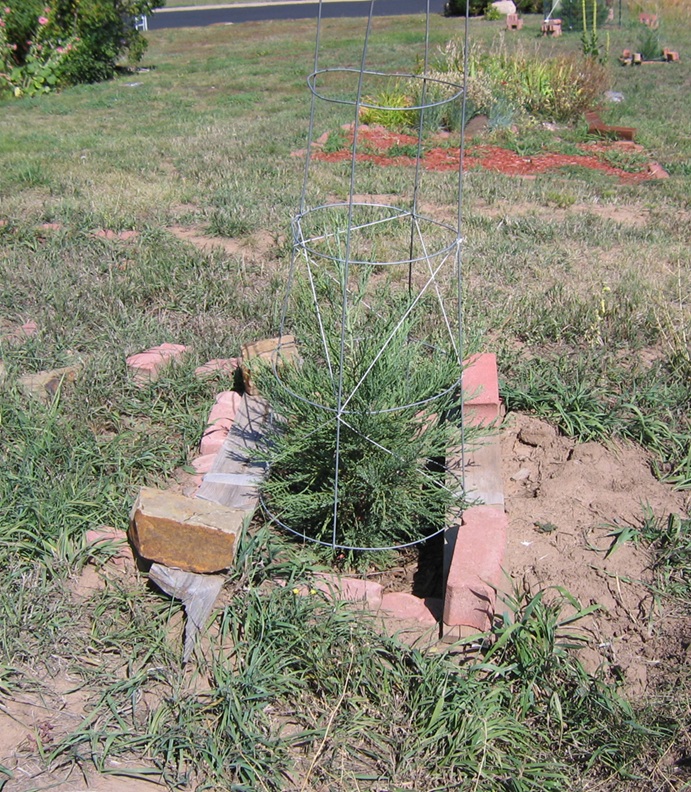
The picture above shows the first of these other seedlings. (The “deer’ tree and one of the seedlings described above can be seen in the background near the upper right edge.)
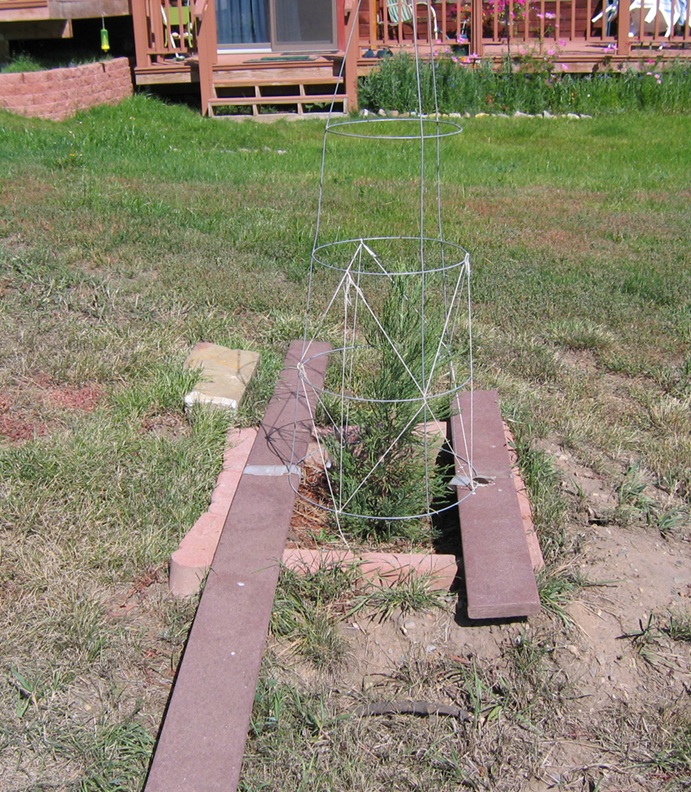
Finally, this 4th picture shows the last of the planted seedlings. Similar to the other trees, it is doing well.
As of early Dec. 2011, all of the above trees have been given a layer of mulch to protect their root systems from winter freezing. In their native habitat in California, Giant Sequoias are rarely subject to subzero weather, but here in the mountains of Colorado, subzero weather can occur before a protective snow layer has had a chance to cover the ground. The root system in older trees will have a chance to grow deeper underground, but young trees will need a year or two before they reach this stage.
As I mentioned earlier, I have moved to my new home. (I haven’t sold my old home yet so I’m still the caretaker for the trees described above.) I have about 30 trees in pots and over 5 acres of land to work with. I will be busy again next spring.
Nov.1, 2012 Update
Another growing season has gone by, and it’s time for an update on the Giant Sequoias.
The bad news is that it has been a very dry year and the “1st grove” of Giant Sequoias didn’t get anywhere near the TLC (i.e. watering) that they had the prior year. The good news is that all the trees are green and growing although the growth this year was much less due to little water supply. I’ve also got 10 seedlings planted at my new home and still have a bunch of potted seedlings that will be planted next year.
The photos below shown the 5 Giant Sequoia trees at my old home as of Aug. 31, 2012
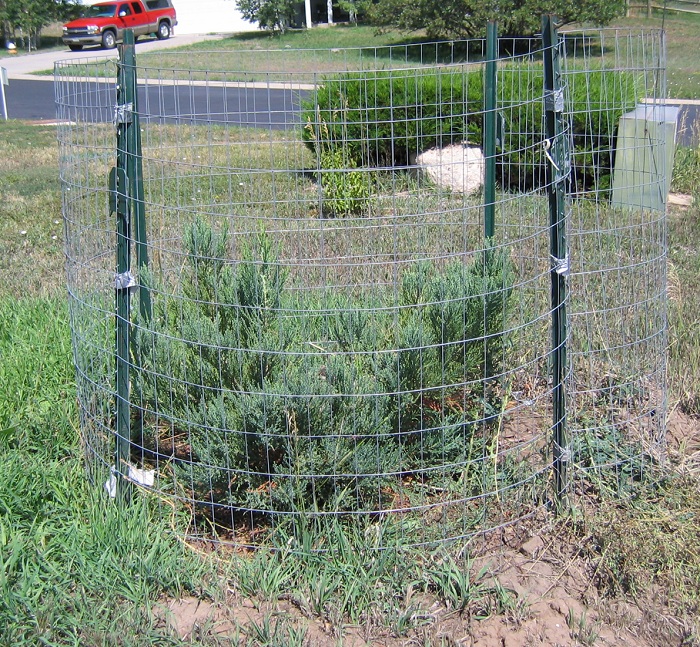
The picture above shows the deer-damaged tree. Last winter’s weather got what looked like what was going to be a new main trunk. The rest of the tree is still growing, but once again, it’s a Giant Sequoia bush.
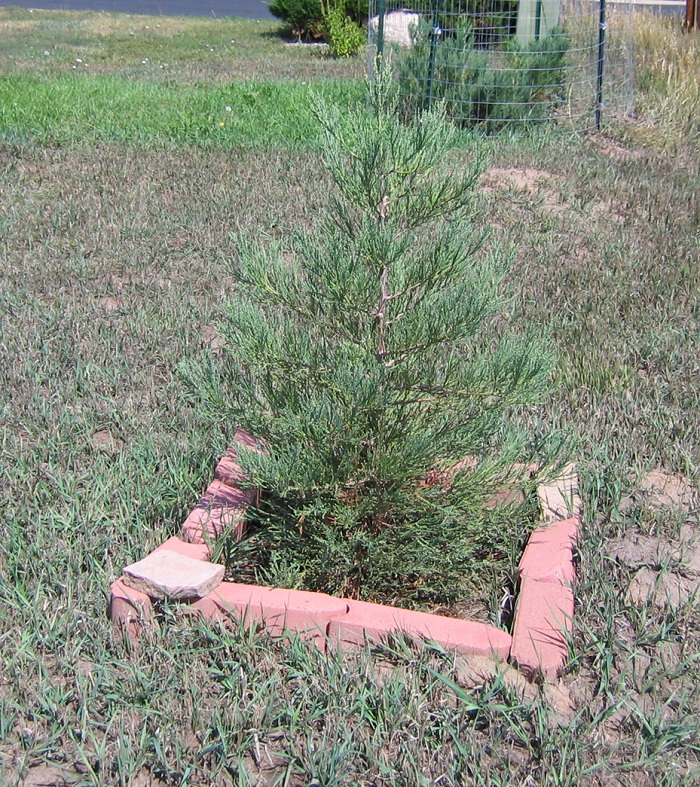
Seedling 1. The next 4 photos show the same 4 seedlings (in the same order) as those shown in 2011. Most have grown about 6 inches which is much less than the prior year’s growth, but then again, they didn’t get much water either. The fact that they survived a year on their own, is encouraging.
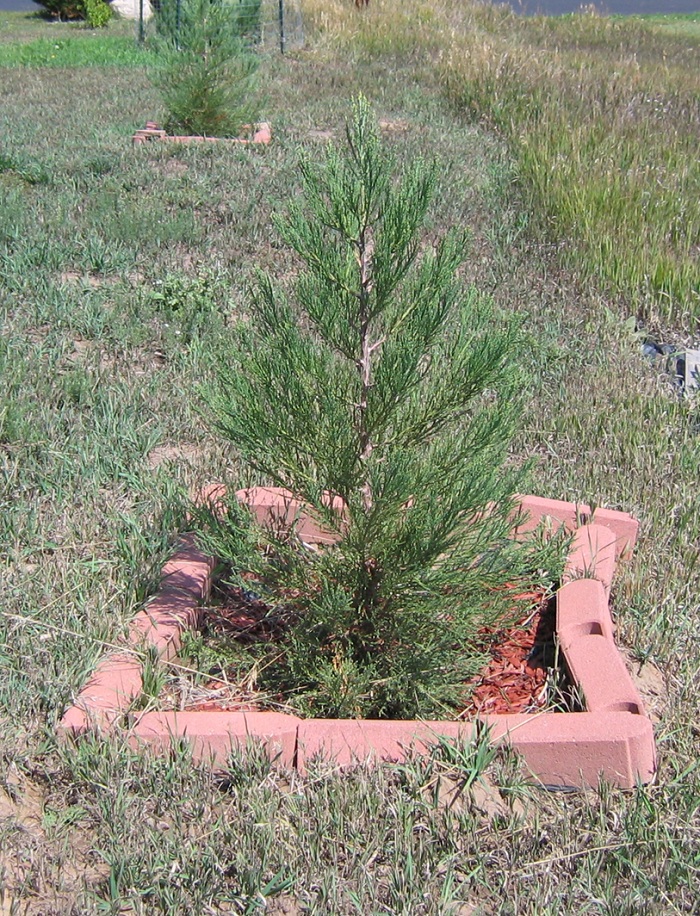
Seedling 2
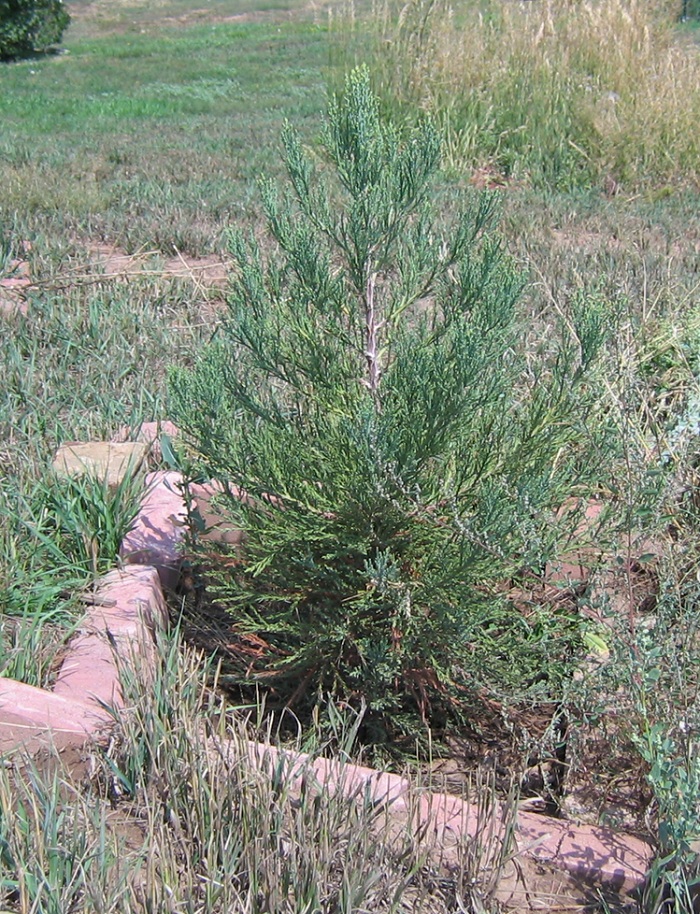
Seedling 3
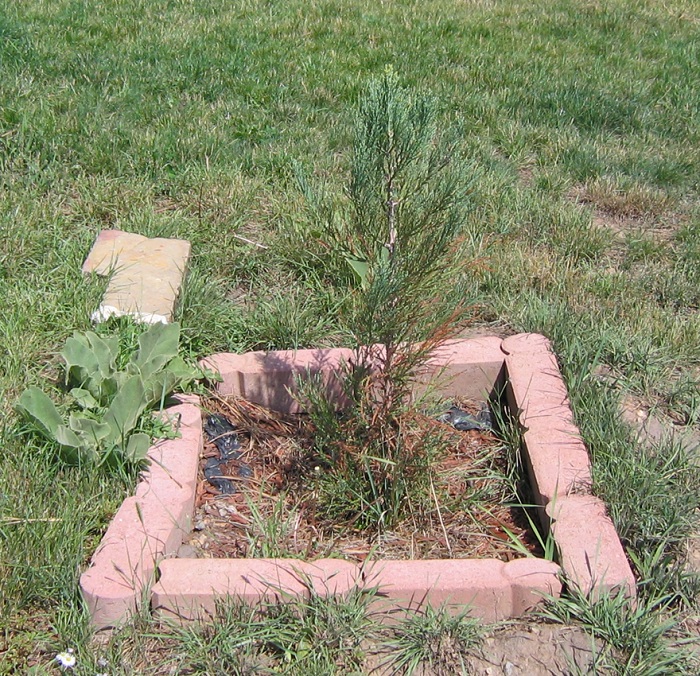
Seedling 4. The 4th seedling is having a little bit more trouble as some of the lower branches have died off. However, it has new green growth on top, and I’m hoping it will eventually do OK.
Sept. 25, 2014
Update
Two years have gone by since I last checked on the Giant Sequoia trees. We have had two more dry years, the trees have been neglected – and 4 of the 5 trees are green and growing. They would be growing more enthusiastically if someone had watered them, but the fact that they have been neglected and are still making it on their own is encouraging.
The photos below show how they looked as of Sept. 25, 2014
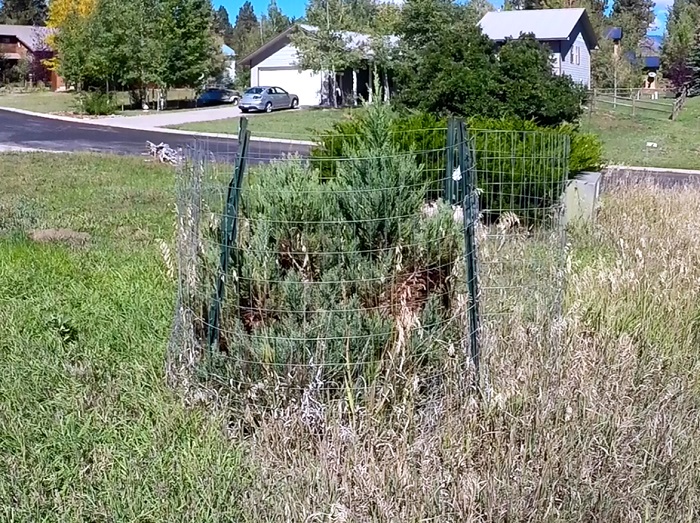
The photo above shows the “Deer Tree”. It still looks more like a Giant Sequoia bush, but the fence is about 4 feet high and the top of the tree is now higher than the fence.
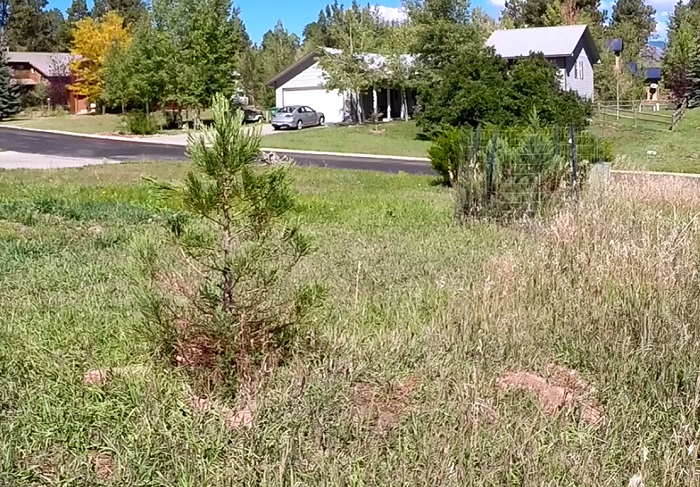
The photo above shows Seedling 1. The “Deer Tree” is to the right along with other bushes and trees in the background.
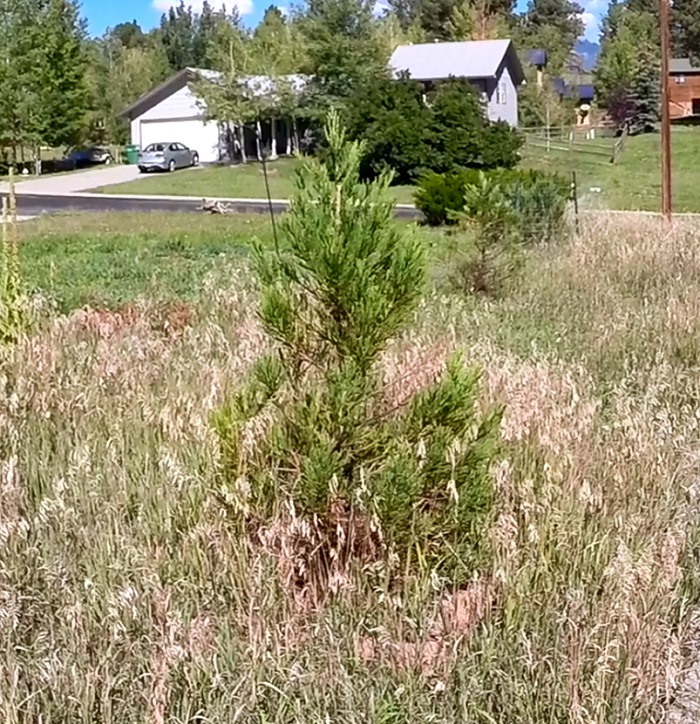
The photo above shows Seedling 2 as well as the first two trees further back. Grass and weeds have grown up around the tree showing how it has been neglected, but the Giant Sequoia is making it on its own.
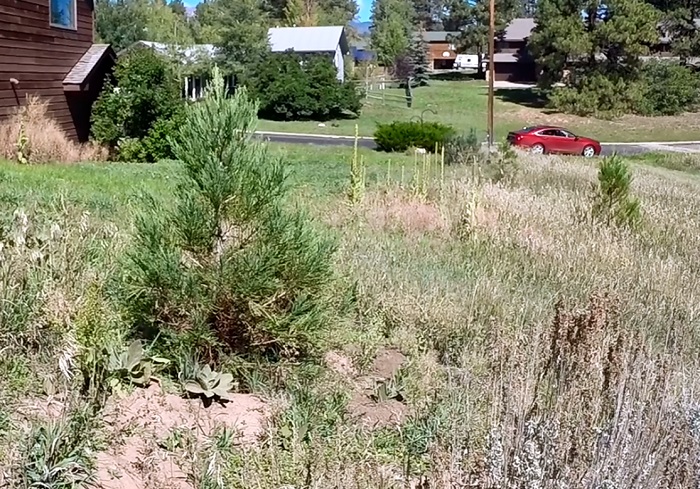
The photo above shows Seedling 3 as well as the other trees in the background. Again, it has been neglected, but it’s making it.
Unfortunately, Seedling 4 is gone. When I last saw it 2 years ago, it was struggling, and assuming it was also neglected, it didn’t make it.
As for the seedlings that I’ve planted at my new home, they are having a more difficult time. The “soil” is mostly rock, and what soil there is doesn’t drain as well. Several of the seedlings have survived for a couple of years, but they are having a rough time. I’ve bought some more seeds which have sprouted in pots. I plan on planting them next spring.
Aug. 12, 2016
Update
Another two years have gone by since the last update, so it’s time to check the trees to see how they are doing. Happily, they are doing well and “growing like weeds”.
The photos below show how they looked as of Aug. 12, 2016
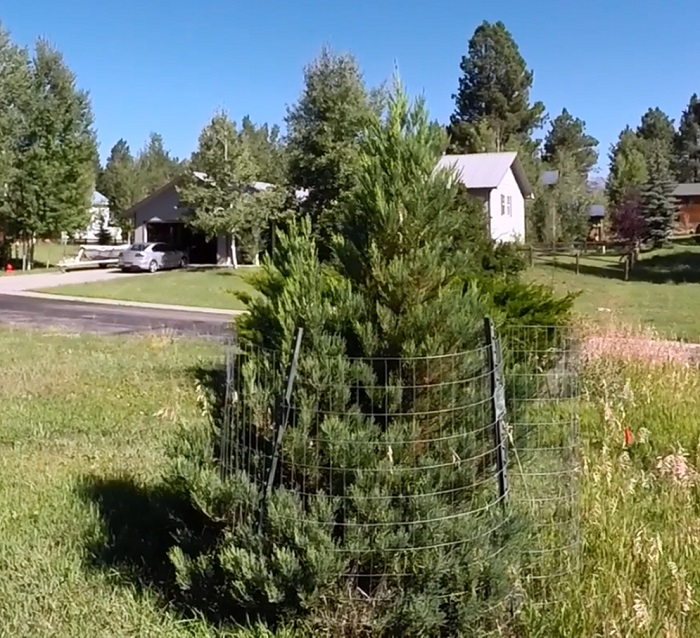
The photo above shows the “Deer Tree”. It’s now over 7 feet tall. Also it’s developed a central trunk so it’s beginning to take on the profile of a regular tree.
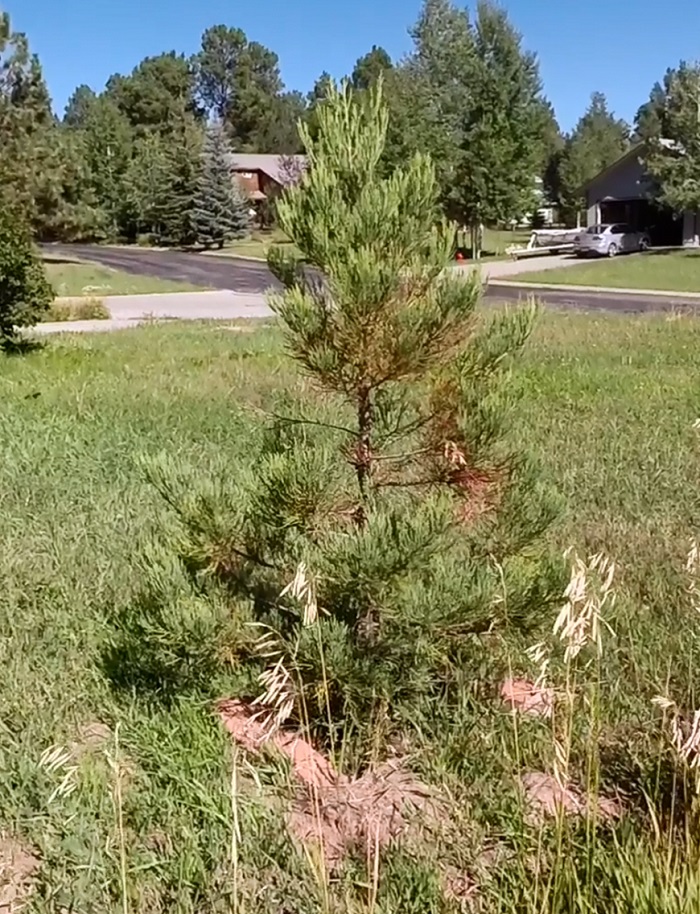
The photo above shows Seedling 1 as of Aug. 12, 2016. It still has some dead branches, but it’s beginning to become “greener”.
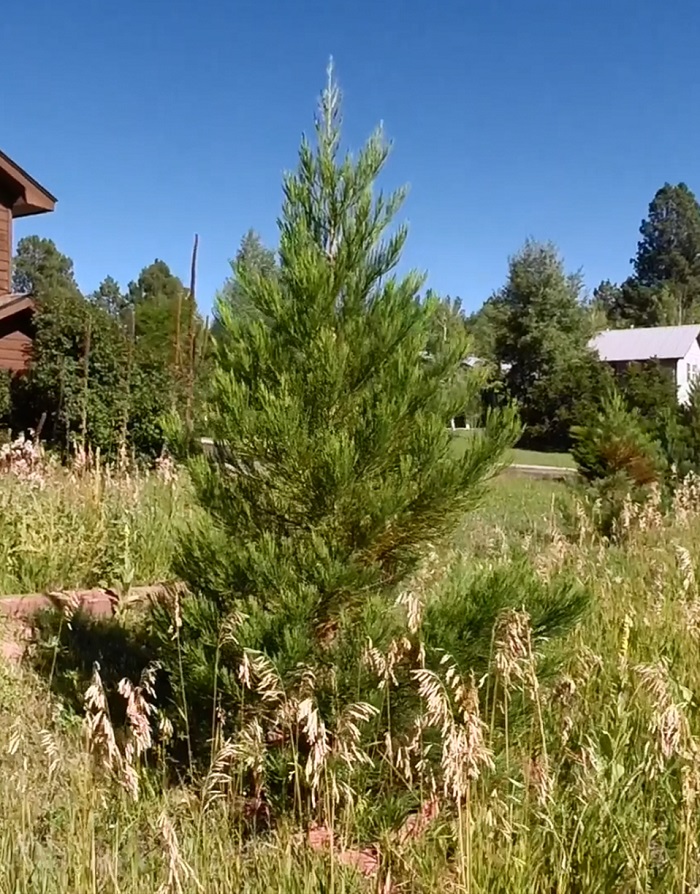
The photo above shows Seedling 2. It’s now a good 7 feet tall.
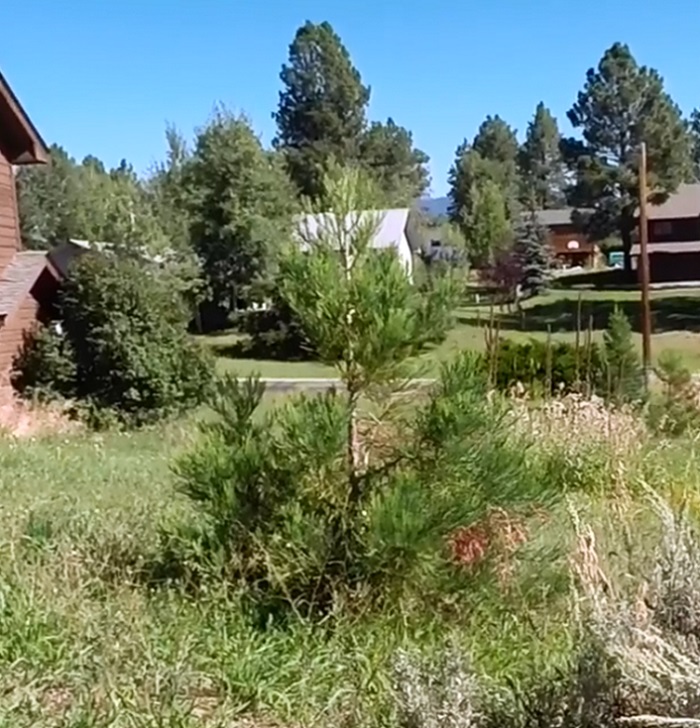
Finally, Seedling 3 is still alive and growing. It’s on top of a small hill and doesn’t have as much ground water, but it’s about 5 feet tall. None of the trees look like they are being watered which in a backhanded way is a good sign. They are making it on their own. Of course they would have to do this sooner or later, but as they grow larger, their root system will expand to tap into whatever water is available.
The New Giant
Sequoias
A dozen Giant Sequoias have been planted at my new home. A video showing them as well as the above trees can be seen at https://www.youtube.com/watch?v=0Un9UoXszMk
Aug. 25, 2018
Update
Another two years have gone by since the last update, and happily, all 4 trees are still “growing like weeds”.
The photos below show how they looked as of Aug. 16, 2018
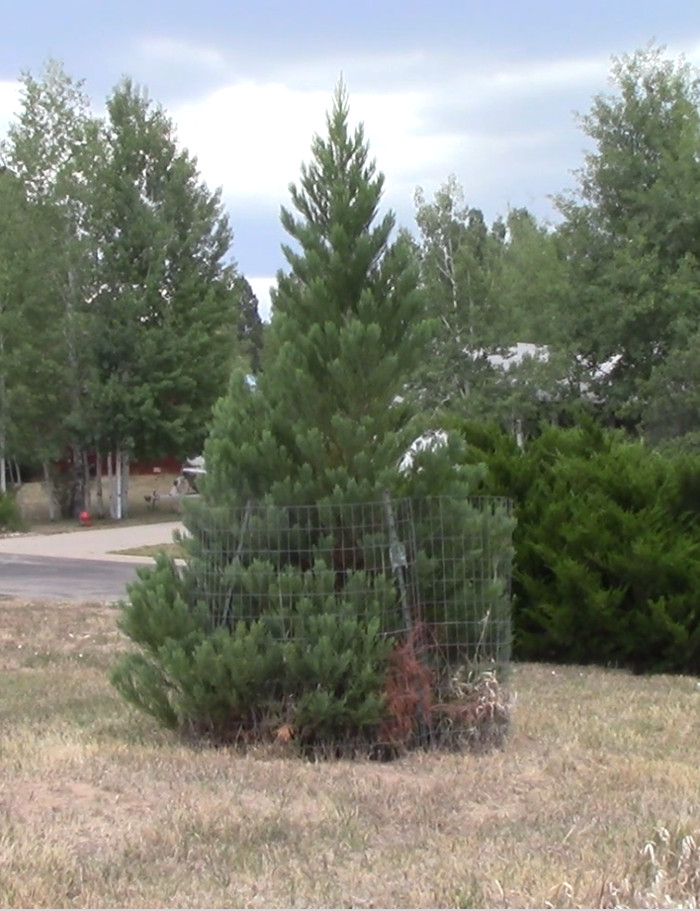
The photo above shows the “Deer Tree”. It’s now about 10 feet tall. This is about 3 feet of growth in the last 2 years. This year has been very dry, and as shown by the dead grass, the trees have not been watered. Yet they are growing on their own.
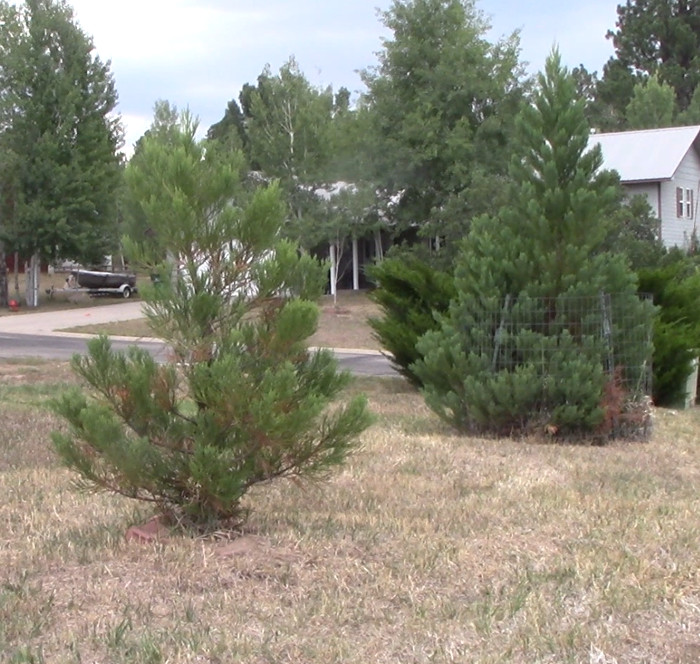
The photo above shows Seedling 1 as of Aug. 16, 2018. It is steadily filling in the gaps where the old dead branches were. The "Deer Tree" is in the background to the right.
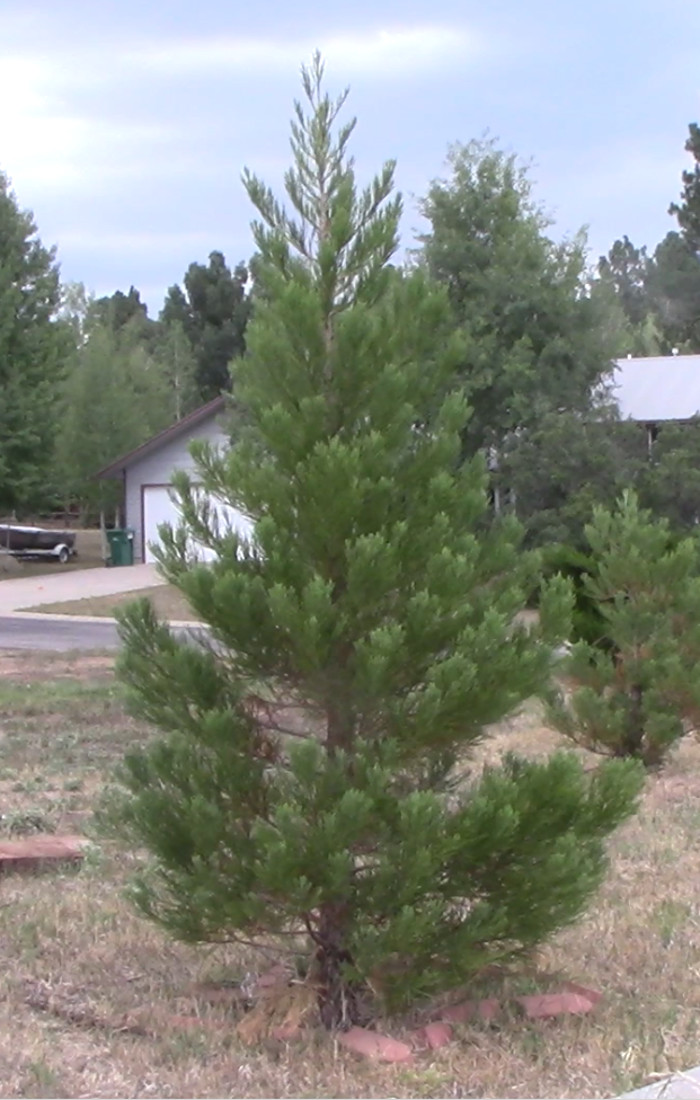
The photo above shows Seedling 2. It’s now a good 8 to 9 feet tall.
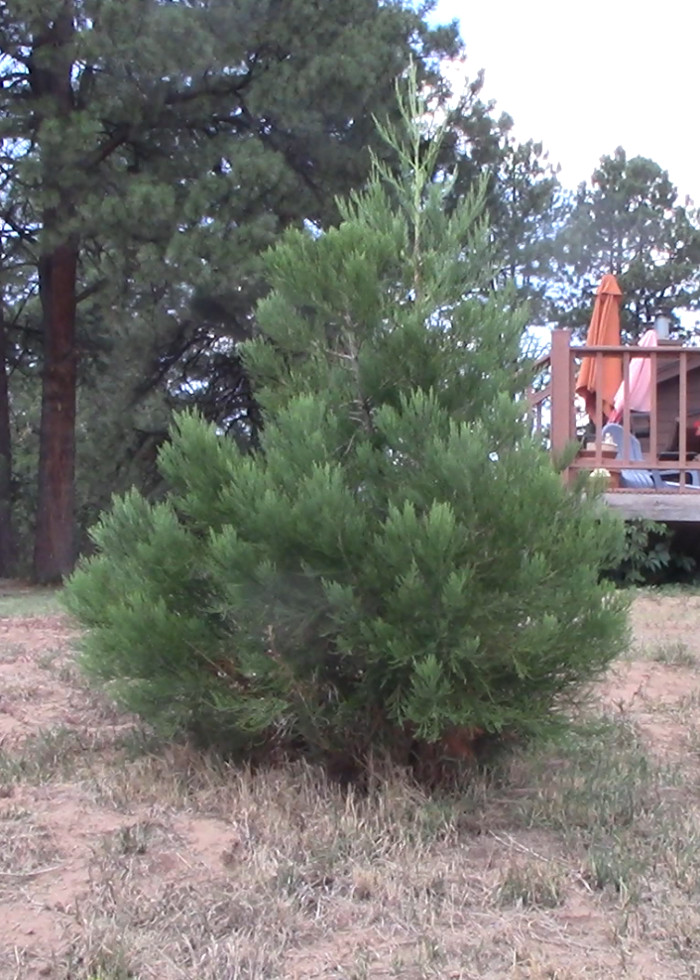
Finally, Seedling 3 is steadily growing. It’s on top of a small hill and doesn’t have as much ground water, but it’s about 6 or 7 feet tall.
Unfortunately, the Giant Sequoia seedlings at the new house are not doing as well. Last winter had very little snow cover with the result that their shallow root systems were subject to freezing. About half of them didn't survive and the rest are stunted and struggling. I have just started a new batch of seedlings and will replace the ones that didn't make it.
Aug 1, 2020 Update
Another two years have gone by, and it's time to check up on how the trees are doing. Fortunately, they are doing well in spite of a very dry spring and early summer this year.
The photos below show how they looked as of July 31, 2020.
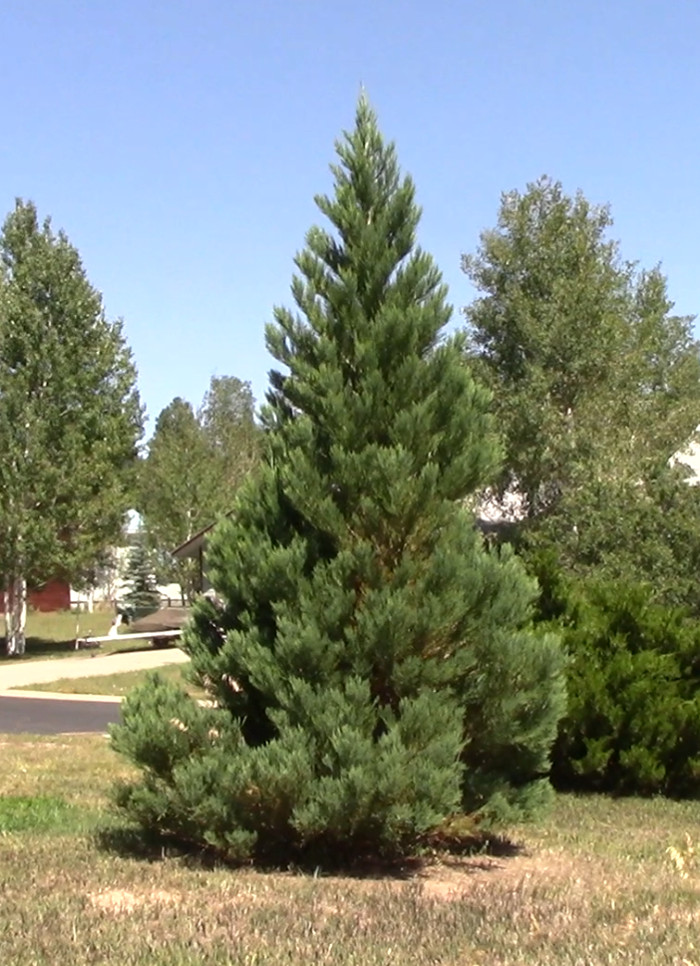
The photo above shows the "deer tree" as of July 31, 2020. It's taken on the classic pyramidal shape of a Giant Sequoia, and shows very little evidence of the "deer" disaster of some 10 years ago. It's now some 12 to 15 feet tall, and continues to grow at some 1 to 2 feet per year.
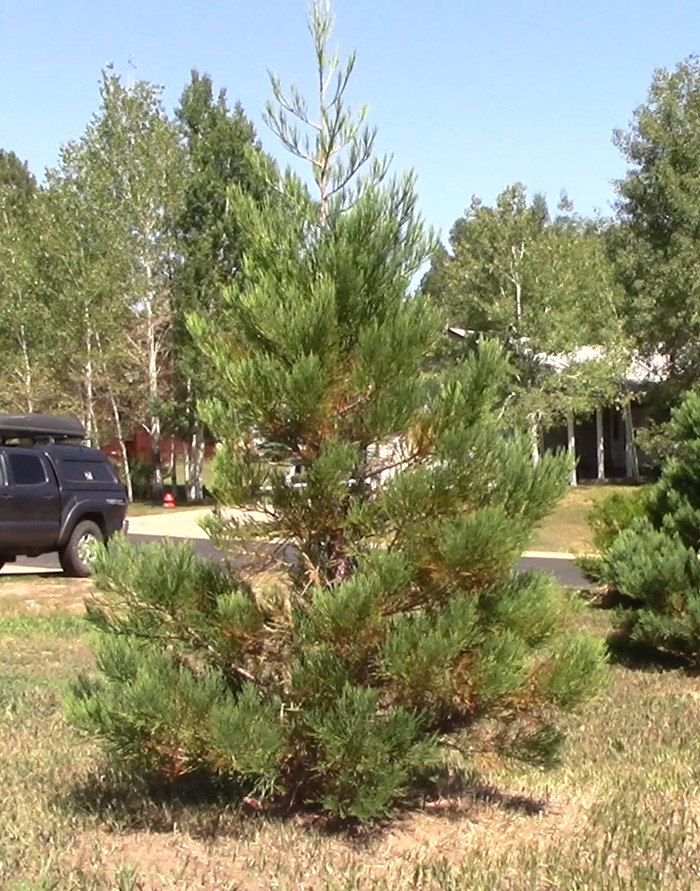
Seedling 1 continues to recover from its original scrawny condition. It is now about 8 to 10 feet tall. The sparse growth in the top branches is a result of the very dry spring that we have had this year.
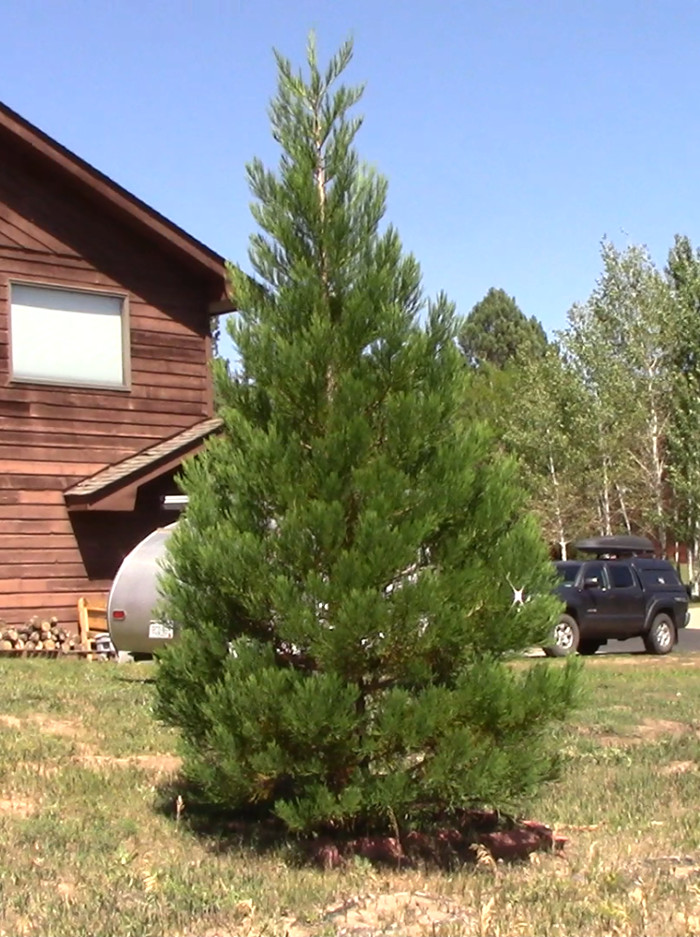
The photo above shows seedling 2 as of July 2020. It's about 10 to 12 feet tall and looking very healthy.
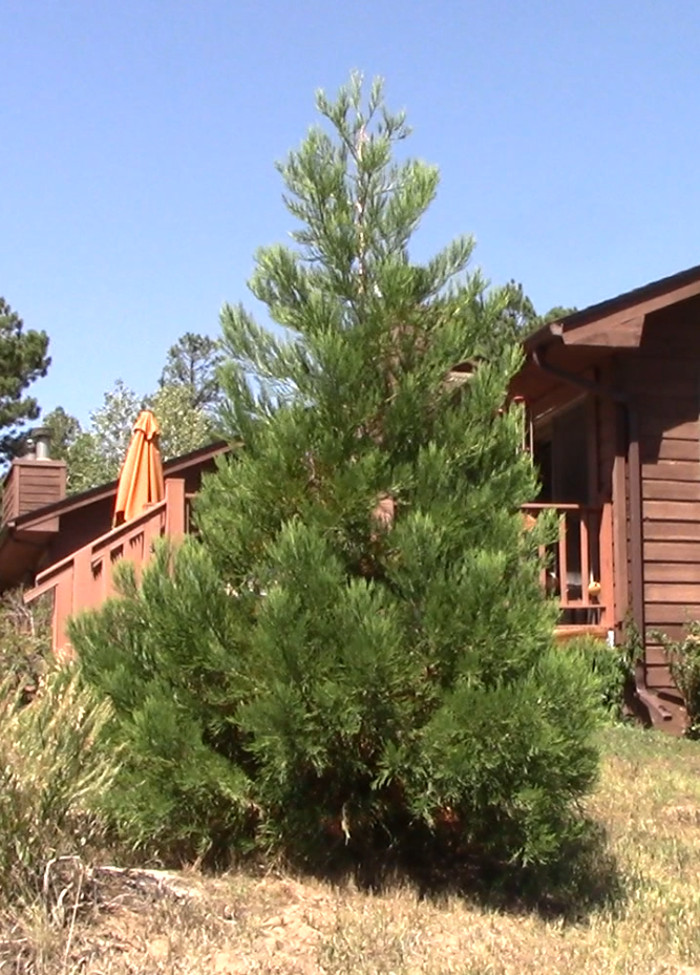
Finally, seedling 3 continues to prosper. It's at least 8 feet tall even though it gets the least amount of water of the 4 trees.
The seedlings that I planted a couple of years ago at my new home are unfortunately not doing as well. A combination of low snow years (where the roots froze) and dry spring/summers have taken their toll, and only one of them is still surviving - and it's struggling. I still have a dozen or so new seedlings growing in pots, and will be planting them when I think there might be a good chance for them to survive.
Return to Durango Bill's Home page
Web page generated via Sea Monkey's Composer HTML editor
within a Linux Cinnamon Mint 18 operating system.
(Goodbye Microsoft)